Slippery Rock University Magazine The ROCK Spring/Summer 2025

INSIDE
In this issue
-
Program, Leadership and Facility Updates
-
Aria Kriebel Experiences Benefits of Study Abroad in Japan
-
Engineering Research Told Through Six Objects
-
Thomas Gaither, Civil Rights Leader turned Biology Professor
-
Seth Jenny, Leading Esports Expert
-
Behind The Scenes of a Theater Production
-
Celebrating the Class of 2025
-
What Amanda Shotts-Habursky Wishes She Knew
-
Brayden Long and New Coaches
-
Ryan Griffin, ’10, the DJ for ESPN’s CollegeDay
-
Gary Charmel, ’86, Reflects on Career and Why He Gives Back
-
University Union
-
Celebrating Our Alumni
-
Renovated Softball Field
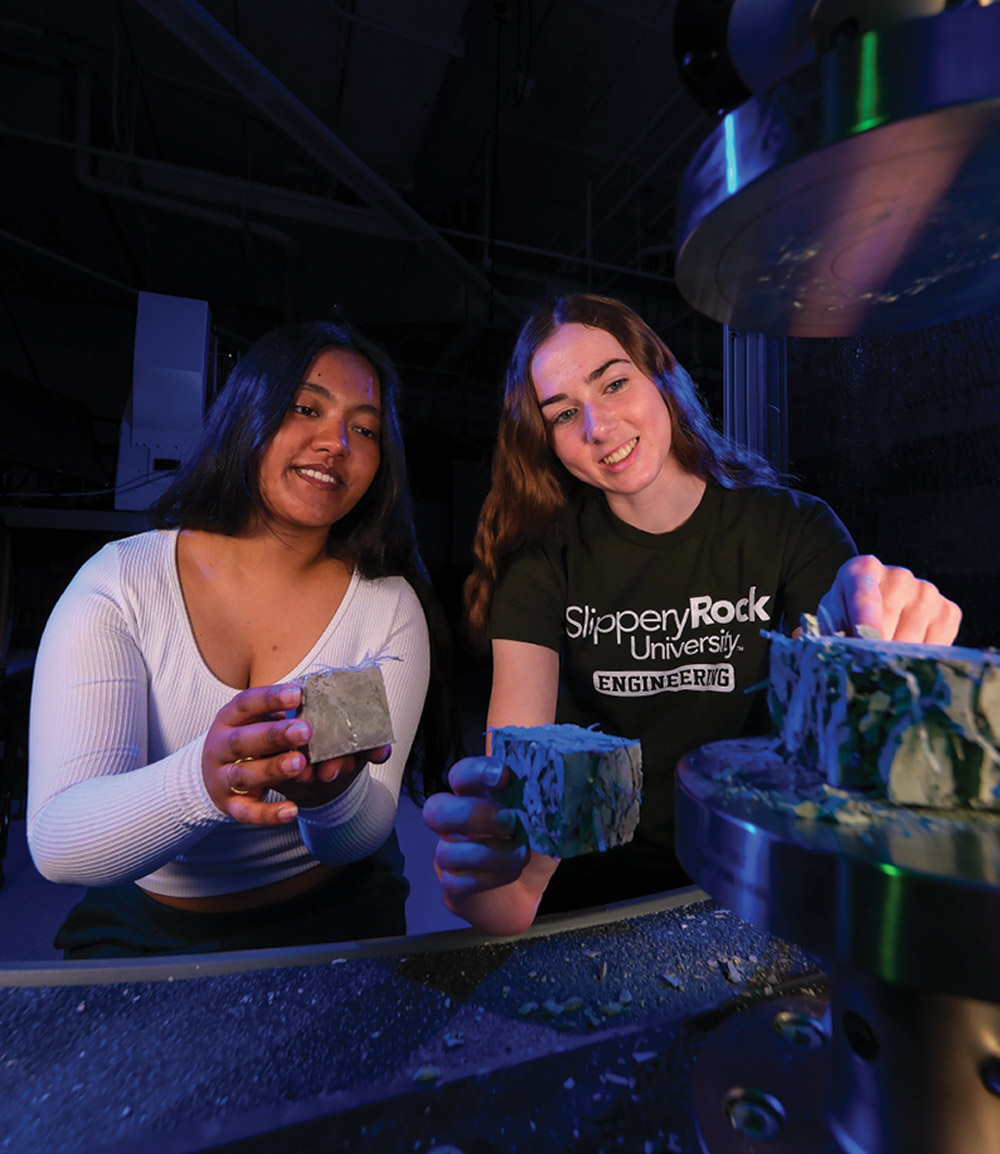
ON THE COVER
Message from the President


Message from the President
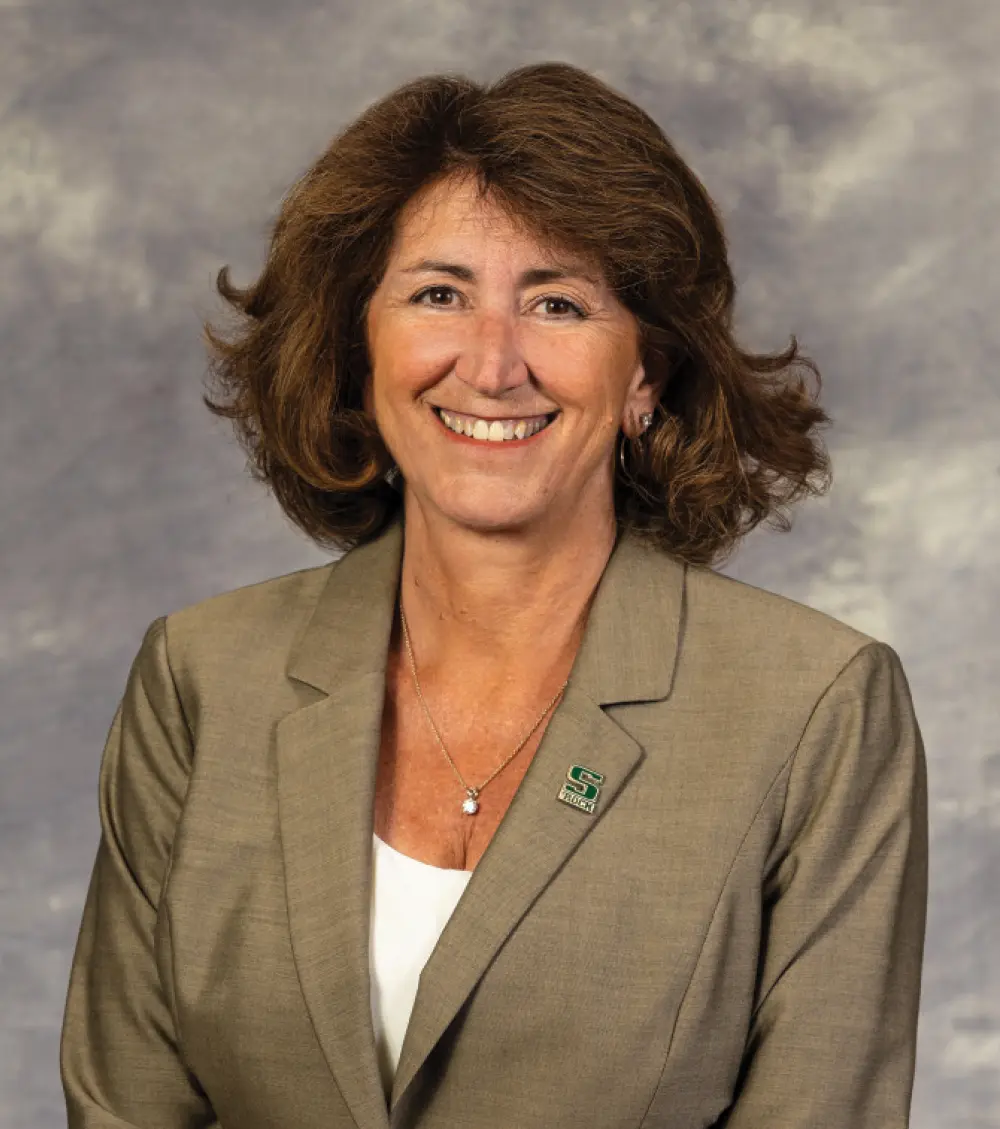

elcome to this edition of the Slippery Rock University magazine. As I reflect on my first two years as president of this remarkable institution, I am continually inspired by the unwavering dedication and support of our alumni, faculty, staff, friends, and partners. Your commitment means that SRU continues to thrive and provide transformative experiences for our students.
In this issue, you will find glimpses of what makes SRU truly extraordinary—our rich history, our present achievements, and the boundless potential that lies ahead, along with stories and images that serve as a celebration of our shared commitment to advancing the University’s mission and shaping the future.
At SRU, we are building upon the strong foundation of our past while embracing the opportunities that define our future.
Our new Campus Success Center and Student Health Center, and innovative new academic programs that support our regional workforce, embody a spirit of renewal and progress that propels us forward.
These initiatives support the many students who call The Rock home and reaffirm our dedication to enhancing the student experience, strengthening the economic impact of our region, and making a positive impact on the world.
While challenges persist across the landscape of higher education—declining enrollment and shifting public perceptions—we are steadfast in our belief that collaboration, determination and a shared sense of purpose overcome adversity.
Our new strategic plan is the framework, guiding us toward continued success. It is built on commitments to delivering an exceptional education at an accessible cost, helping to ensure that we are serving the needs of our students, their families, and our community.
We are determined to have SRU be a first choice: for student learning, for employer hiring, for faculty and staff success, and for community groups and organizations looking for a partnership to advance our region.
I invite you to immerse yourself in the vibrant stories and accomplishments you will find in this magazine and to deepen your connection with us by attending campus events, contributing to scholarships, or mentoring our students.
Your involvement strengthens us and inspires us. Together, we hold the power to shape lives, ignite dreams, and create a legacy that will inspire generations to come.
I am grateful for all you have done to support Slippery Rock University, and I look forward with optimism and enthusiasm to the future we will build—together.
With gratitude and best wishes,

President, Slippery Rock University
University
News
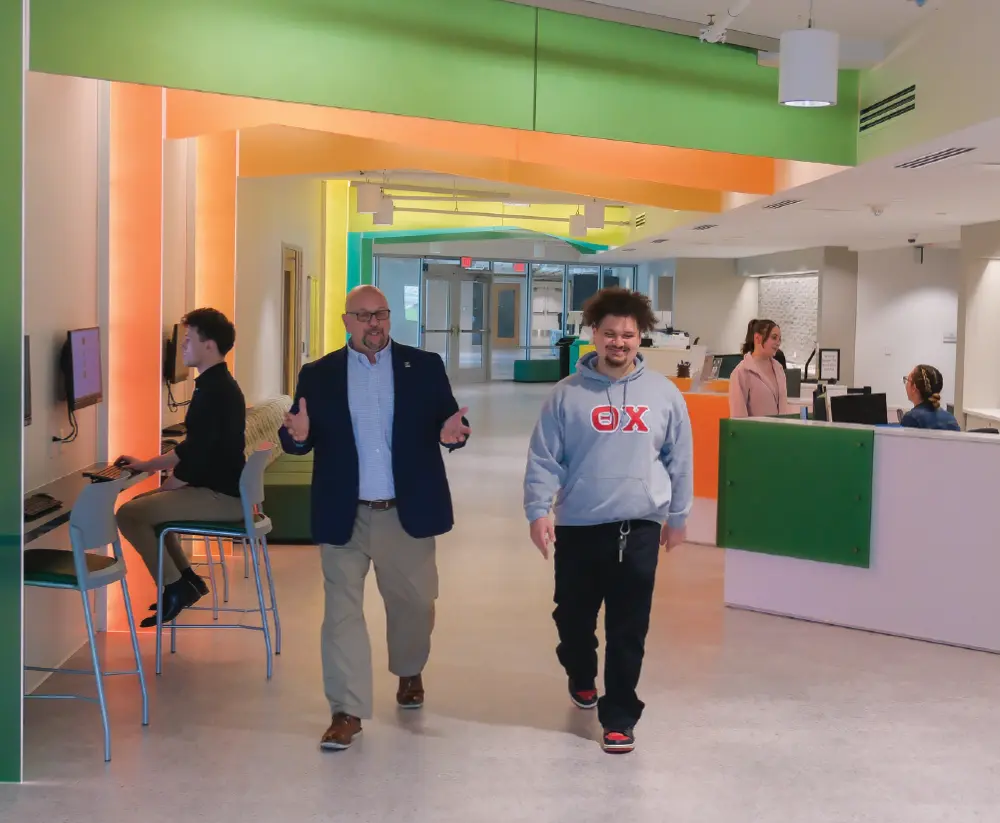
Open for Success
Successful alums start with student success. The new Campus Success Center is where students meet with dedicated professionals to help them achieve their personal best. It’s where eight certified academic life coaches engage and empower students through innovative methods that go beyond prescriptive advice, helping them design their own path.
The new space is also home to increasing opportunities for students to connect with future employers, with more than 10 hiring events featuring over 300 employers planned next year.
From career fairs and single-employer meet-and-greets to tailored sessions with coaches that optimize students for career success, the new center is the place where connections are made and dream jobs are shaped into reality.
Rock-Solid Selectivity
Most selective college or university in the Pittsburgh area (behind only Carnegie Mellon), and the
Most selective college or university in Pennsylvania.

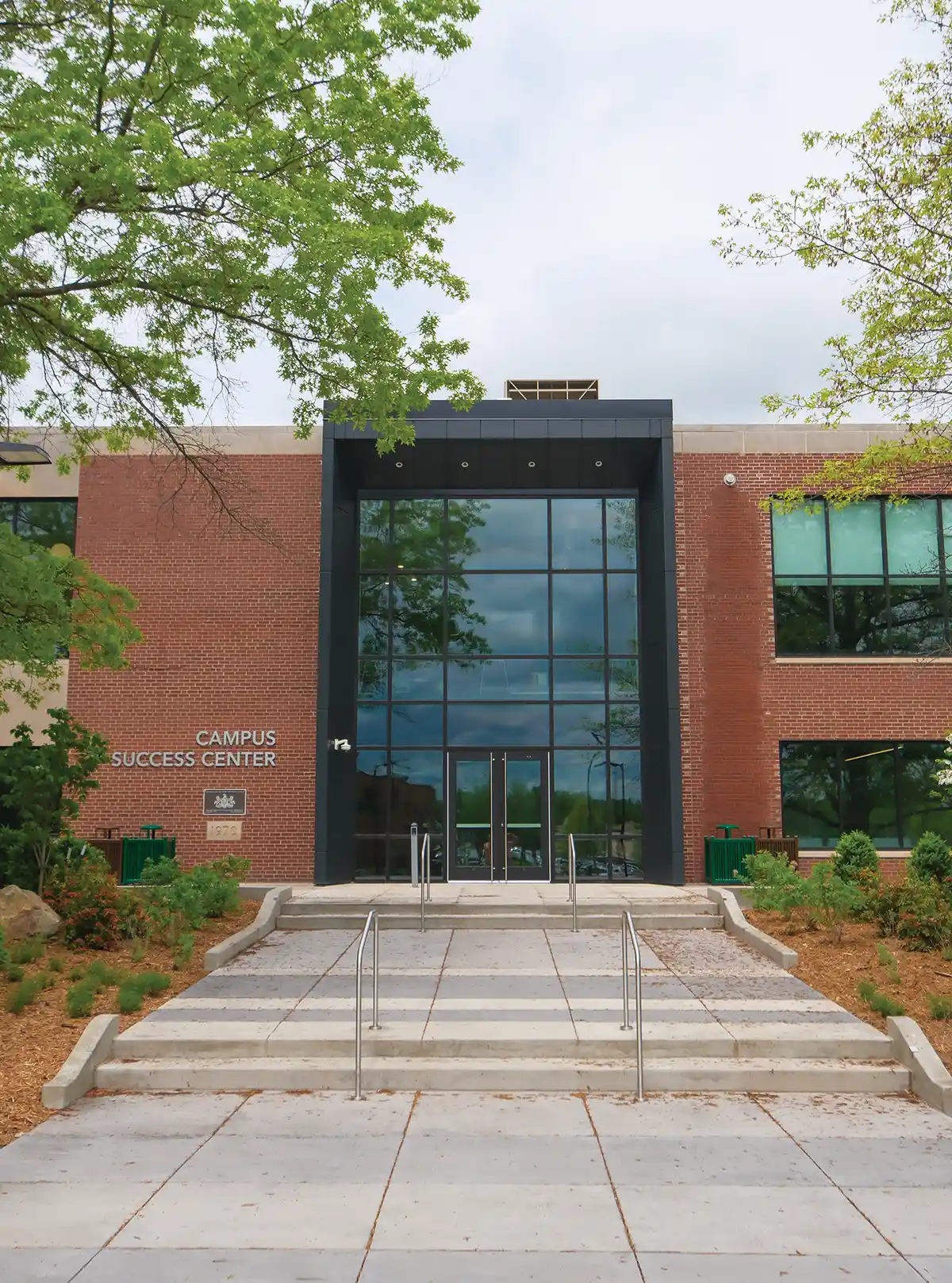

This modern facility houses the:
- Office of Disability Services
- Financial Aid Office
- Dean of Students Office
- Mailing Services
- Parking/ID Office
- Student Counseling Center
- Center for Career and Academic Progress
- Student Health Center
Student Health Center
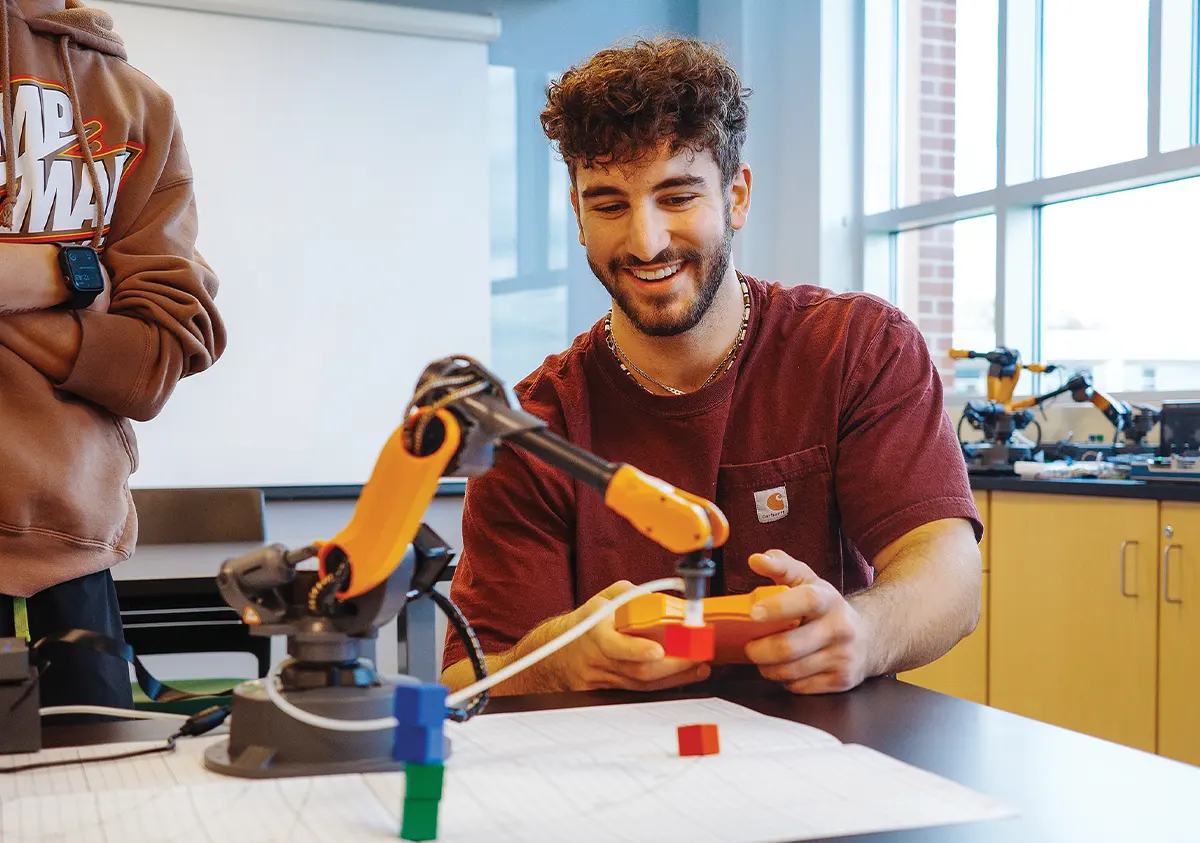
Program Growth
Electrical and
Computer Engineering
Construction
Management
Nursing
1+2+1
Electrical and
Computer Engineering
Construction
Management
Nursing
1+2+1
Executive Hires


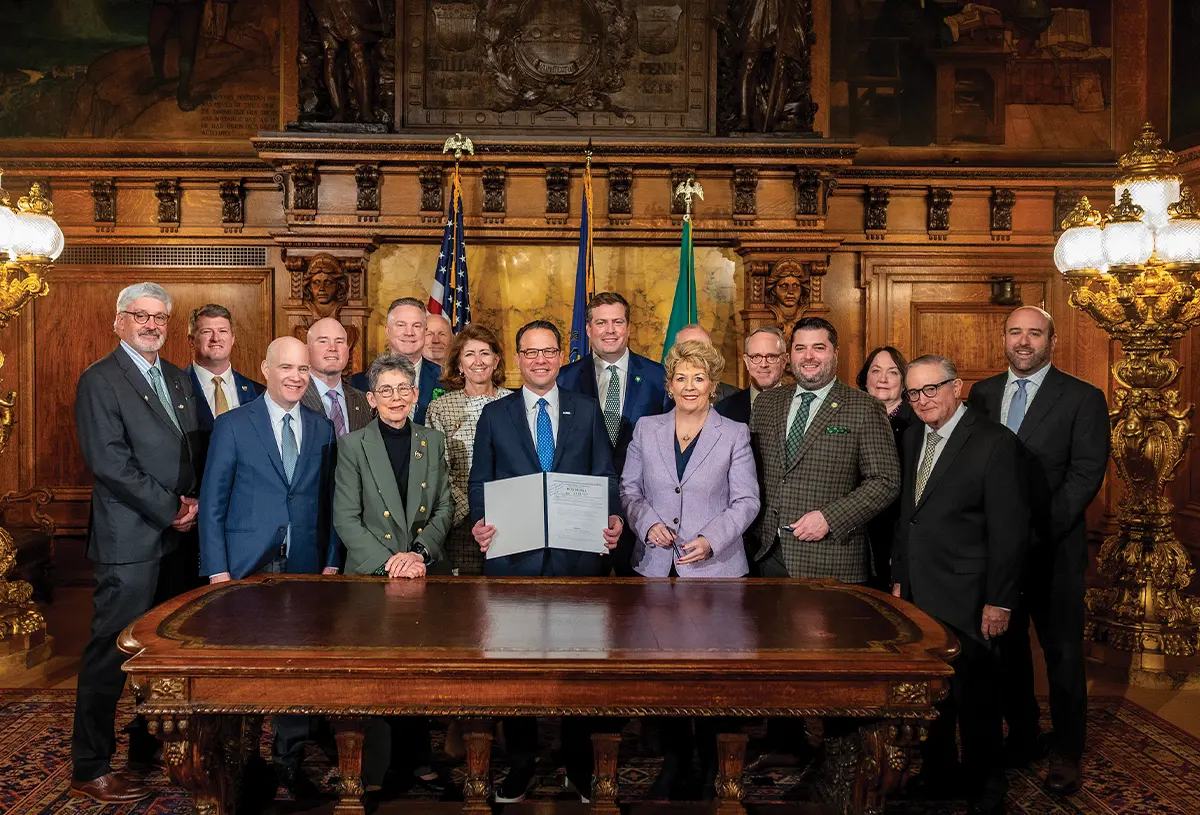
Economic Advocate
Global Impact

he clouds look the same no matter the country, but cultures across borders are unique. Aria Kriebel knows this. She always takes a moment to admire a new country as she prepares to land. Her destination: Japan.
Kriebel is a Slippery Rock University senior strategic communication and media major from Lyndora, Butler County. She accompanied her classmates for a trip to Japan last spring led by Yukako Ishimaru, an SRU instructor of language, literatures, cultures, and writing.
What Kriebel didn’t know was that this trip would fulfill her lifetime dream of visiting Japan and deepen her passion for traveling.
“It is incredible to watch a classroom lesson turn into a real-world experience,” said Ishimaru. “I have watched Aria and many of my students grow while abroad. To learn about a country and then experience it firsthand can be a transformative journey for many students.”
During her 10-day trip, Kriebel spent an afternoon among Japanese students at Saga University, visited the Dazaifu Shrine, took painting and pottery classes, and explored other Japanese cities like Nagasaki. Prior to her trip, Kriebel had traveled to Canada and the Netherlands, but having an organized trip with professors and fellow SRU students has expanded her horizons and stirred her wanderlust. She plans to visit the United Kingdom and France in 2025.
“The time and effort I put into learning Japanese inside and outside of the classroom paid off while visiting Japan,” said Kriebel. “Having a prior knowledge of Japanese made me feel more connected to people I interacted with. I fell in love with Japanese music in high school and wanted to understand the lyrics, so I taught myself the writing systems of Hiragana and Katakana. Using those skills in Japan was incredible, and I’m so glad I didn’t give up on my passion.”
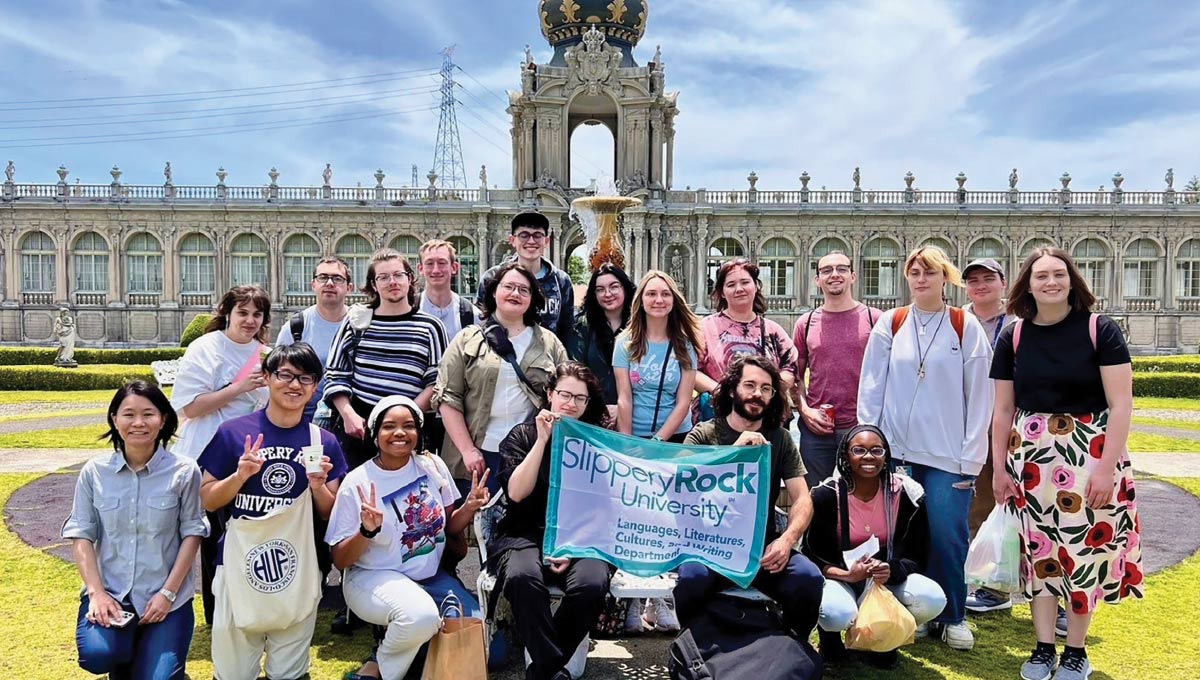
Study Abroad at SRU
“Students can study abroad from any major, for any length of time, in any place in the world — it is self-designed,” said Jenny Kawata, SRU’s director of global exchanges and partnerships. “Many of our students who travel abroad say that it is the most impactful experience that they’ve had during their time in college. It makes a big difference for attracting and retaining students, and, most importantly, setting them up to succeed.”
Turning Lessons into Lived Experiences
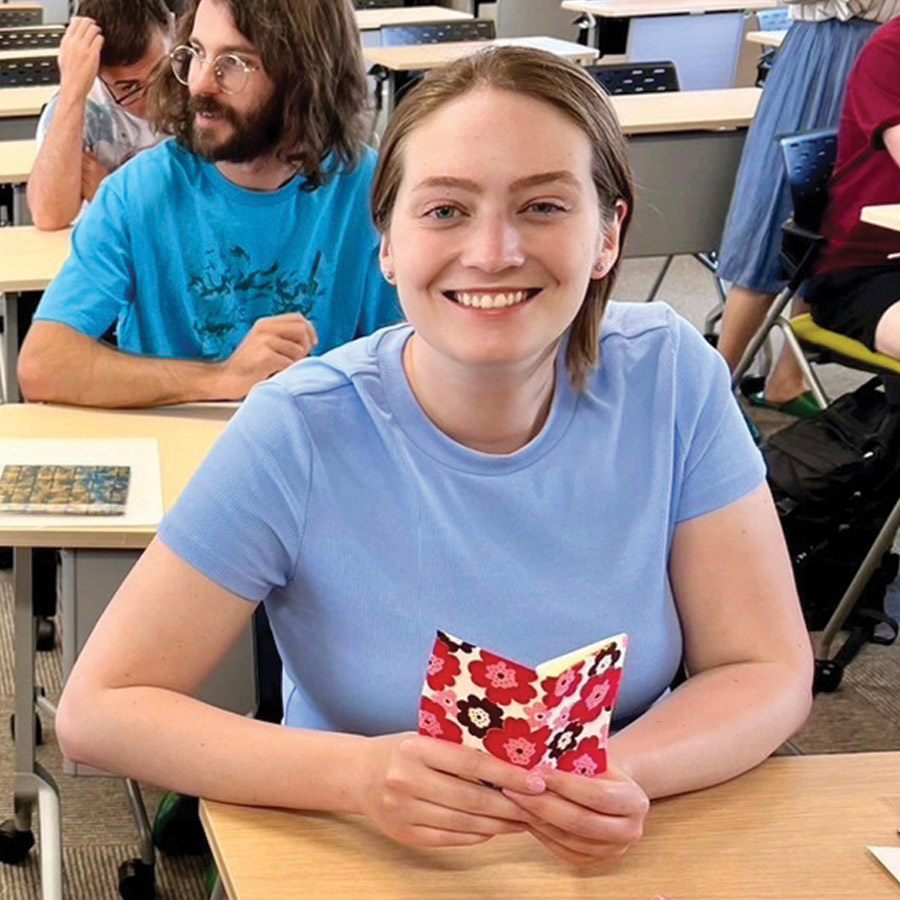

While in Japan, Kriebel spent an afternoon with students at Saga University, where she learned about their lives, education system and personal experiences. Learning about institutional structures and meeting the people within them was the bridge between theory and practice.
“The best part of my trip was meeting students my own age and learning about their lives. We had so much in common, but also so many differences like how we approach daily life, work and communication,” Kriebel said. “Japan taught me how nuanced communication can be. It’s not just about what you say, but how you say it, and the context in which you say it.”
This cultural immersion wasn’t limited to conversations. Time spent at the Dazaifu Shrine taught Kriebel about traditional Japanese customs, which was further enhanced by hands-on activities like painting and pottery classes.
“The shrines were beautiful, I even had the chance to wear a kimono and partake in a traditional tea ceremony,” Kriebel said.
Building Bridges Across Cultures
“I was able to introduce some of the students to American music, customs and even some interesting words we use,” said Kriebel, who noted slang terms that amused the Japanese students, like “cookin’” to describe something impressive. “Just sitting down and having a conversation taught us all so much about our countries.”
These exchanges reinforced her belief that despite the differences in customs, language or traditions, people around the world are trying to achieve similar things: they want to be understood, they want to grow and they want to connect with others.
Lasting Impact
The experience in Japan allowed Kriebel to take the knowledge she had gained in the classroom and apply it in real-world situations. It contributed to a more well-rounded education, expanded her worldview and gave her a deeper understanding of a culture she has always admired. It will also help her develop skills and traits that employers desire.
According to Kawata, students who study abroad see boosts in their critical thinking, self-confidence, and cultural awareness and appreciation that leads to greater understanding in professional settings.
In other words, students like Kriebel are ready for whatever comes next, even if that’s more stamps on her passport. After graduating from SRU, Kriebel is pursuing a master’s degree in communications, culture and creative industries from an online school based in Sweden. She is interested in working abroad as a copywriter or for a nonprofit organization.
“I’ve learned that learning never stops,” Kriebel said. “I have so much to learn about cultures around the world. I can’t wait to see where my journey takes me next.”
Fixing on Six
The future is in the hands of SRU engineering students. Here are six items they handle in the labs that have real-world implications.
hat does a concrete block, a plastic wrench, coffee grounds, an air heater, a spiked shoe and a bucket of sludge all have in common? These aren’t tools to survive a hypothetical scenario on a deserted island. They are six items that, on any given day in the engineering labs at Slippery Rock University, students are handling to solve real-world problems.
In the SRU Engineering Department, “practical, hands-on experience” is not an overused expression. That’s because there’s more action to back up those words. Faculty and students are busy getting their hands dirty, often literally.
Across six laboratories on campus, some of which also function as classrooms with modular equipment, SRU students are gaining experiences and learning through projects led by faculty with industry experience and insights. The work occurs in the labs and outside in the community. The following are only a sampling of projects happening at SRU, using six objects that might seem random or insignificant, but they tell a story that makes a huge impact for academic discovery and human growth.
From top down, Amina Tandukar and Amber Maurer, Nicco Mickens and Ashley Rimmel gain hands-on experience by working on projects in SRU’s engineering labs.
Amina Tandukar and Amber Maurer (above), Nicco Mickens and Ashley Rimmel (below) gain hands-on experience by working on projects in SRU’s engineering labs.
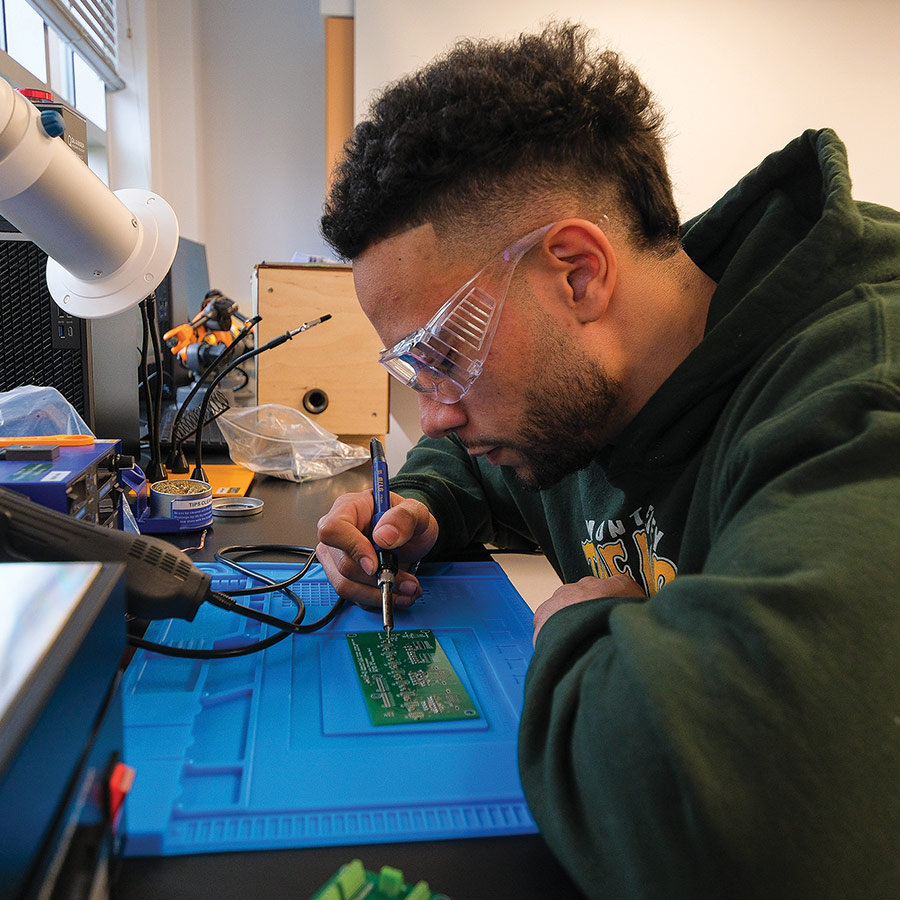
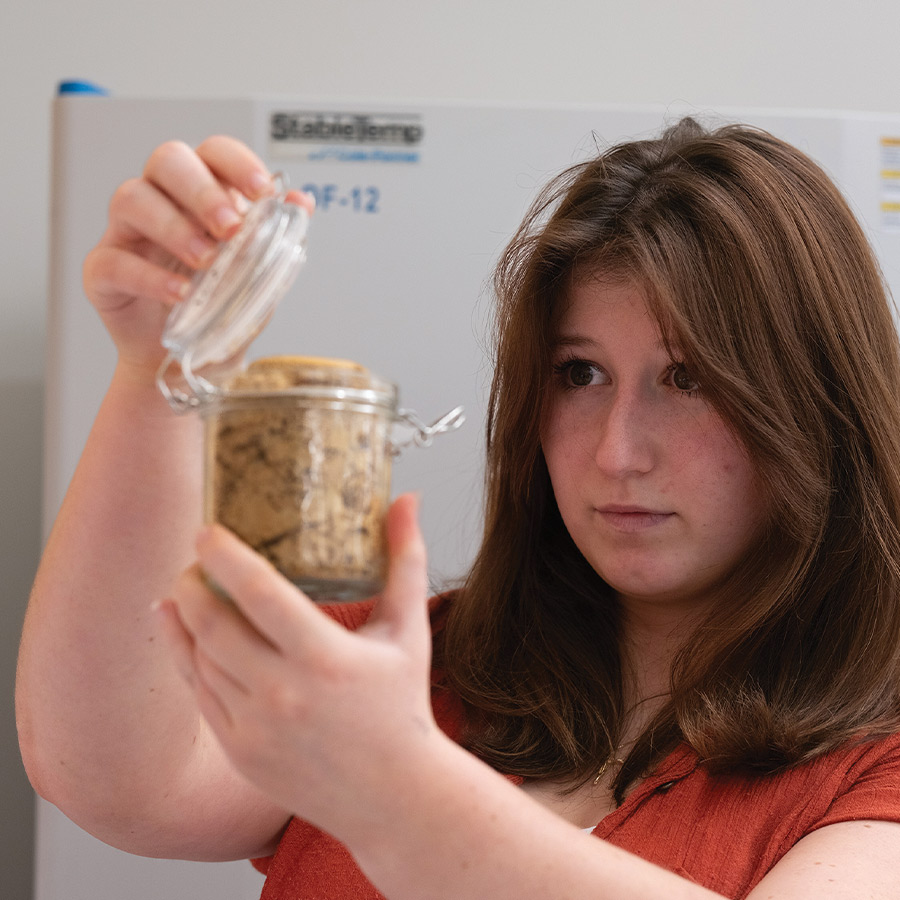

1
Sludge and a Nudge
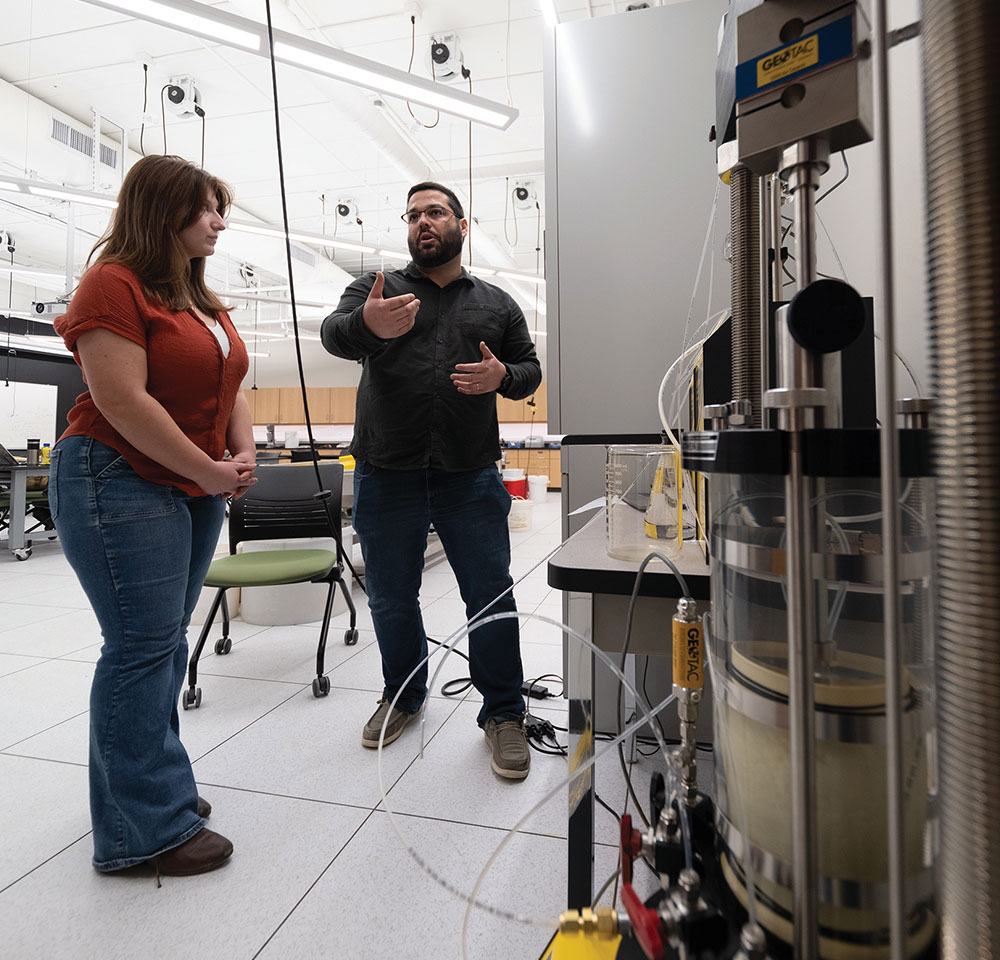

“This project is a great way to move us forward as engineers because we are giving purpose to pollution.”

Josephine Reott, a senior from Butler, is working on the design of the mobile unit, including its greenhouse roof. Amina Tandukar, a sophomore from Kathmandu, Nepal, is working on the dewatering properties of the sludge and how much energy is required to obtain the solid byproduct. Ashley Rimmel, a junior from Ford City, is operating a triaxial machine in the SRU lab to test different loading conditions of soil to determine a safe way to slope the materials on the mobile dewatering system to prevent landslides.
“This project is a great way to move us forward as engineers because we are giving purpose to pollution, something that is not useful, and monetizing it or offsetting the costs that are needed to treat waste,” Reott said. “In our classes, we’ve done so many different tests, so it’s cool to do some of the same tests but on site in projects as professional engineers.”
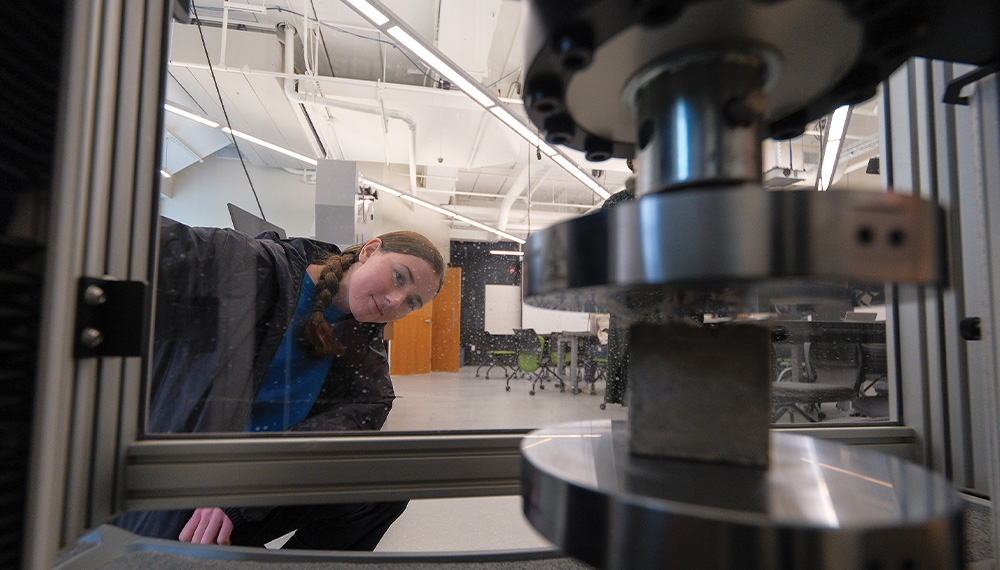
2
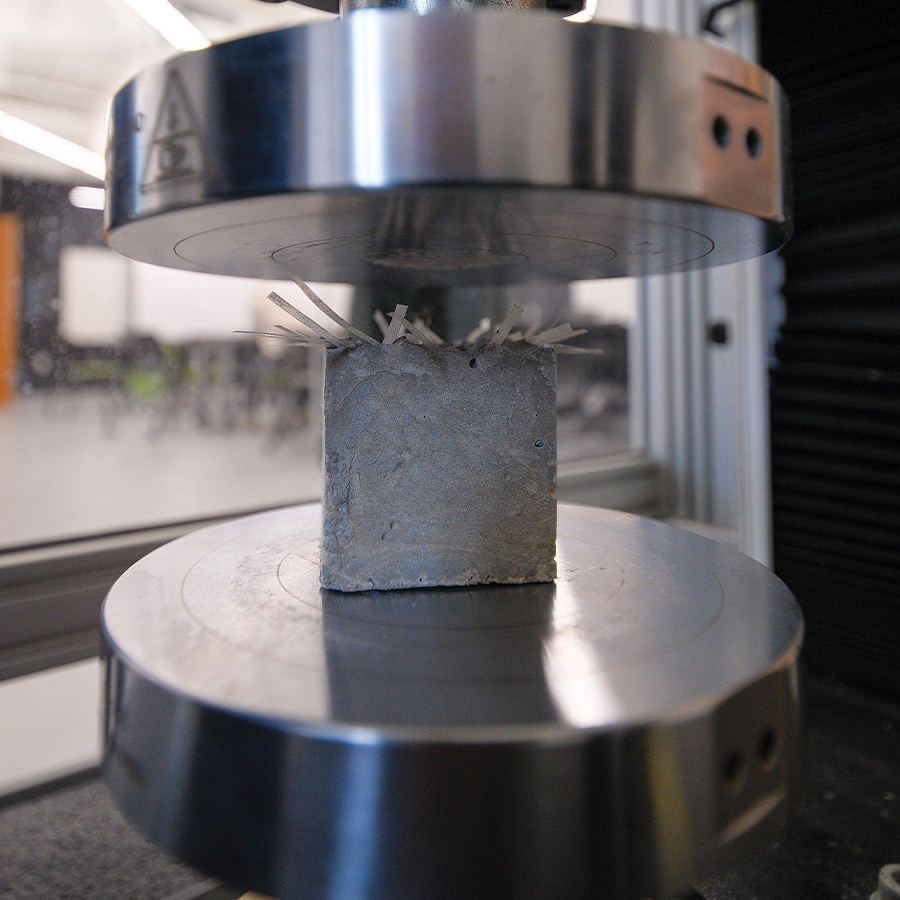


Concrete Knowledge
Just across the hall, in the Mechanics of Materials lab at SRU, Tandukar is working on a separate project that compares different compositions of concrete. By experimenting with different synthetic fibers in cement-based composites, researchers at SRU are coming up with ways to make cement buildings and sidewalks more resistant to stress.
Tandukar and Amber Maurer, a senior civil engineering major from Cowansville, are research assistants under the advisement of Robabeh Jazaei, associate professor of engineering. They tested three types of four-inch cube samples by curing them in water, drying them and compressing them in a testing machine. The amount of stress applied averaged 25 megapascals, which is about 3,600 pounds of force per square inch, before they start breaking.
“Having more resistant composites that last longer will decrease the materials that people need for infrastructure,” Maurer said. “We wouldn’t have to rebuild a sidewalk every 20 years and that will reduce the carbon footprint.”
Maurer and Tandukar have presented research at global research conferences, including the International Mechanical Engineering Congress and Exposition.
“It’s really good to have hands-on experience because that’s what employers are looking for,” Maurer said. “They want to see people who’ve been going out of their way to experiment with the materials that they’re going to encounter in the field. That is beneficial for students here at SRU.”



3
3D Ingenuity

Some students get to compete with one another. In a Manufacturing Processes class taught by Jheng-Wun Su, assistant professor of engineering, students were tasked with designing a wrench with a 3D printer. The lightest and strongest wrench that could output the most torque on a 19-millimeter hex nut would win. The first-, second- and third-place winners were mechanical engineering majors Jennifer Cichra, a junior from Renfrew; Michael Rozic, a junior from Cranberry Township; and Alexander Vollmer, a junior from Saint Marys.

From left, Alexander Vollmer, Michael Rozic and Jennifer Cichra created the lightest and strongest wrenches in their Manufacturing Processes class using 3D printers.
“I learned a lot because I had to figure out the different stress points and what I needed to fix on my project to make it the best that it could be,” Rozic said. “We have great professors here and it is always a combination of in-class and out-of-class work. We had introductory level teaching that Dr. Su showed us, but then we worked through hours of different designs and figuring out how we can optimize it.”
Also working outside the classroom, Cichra was able to develop a separate project on her own using a 3D printer to create a spike plate that straps to people’s shoes that can assist with fall prevention in slippery conditions. Her design was the runner up in the Society of Manufacturing Engineers Digital Manufacturing Challenge, competing against teams from the top universities around the nation.

From left, Alexander Vollmer, Michael Rozic and Jennifer Cichra created the lightest and strongest wrenches in their Manufacturing Processes class using 3D printers.
4
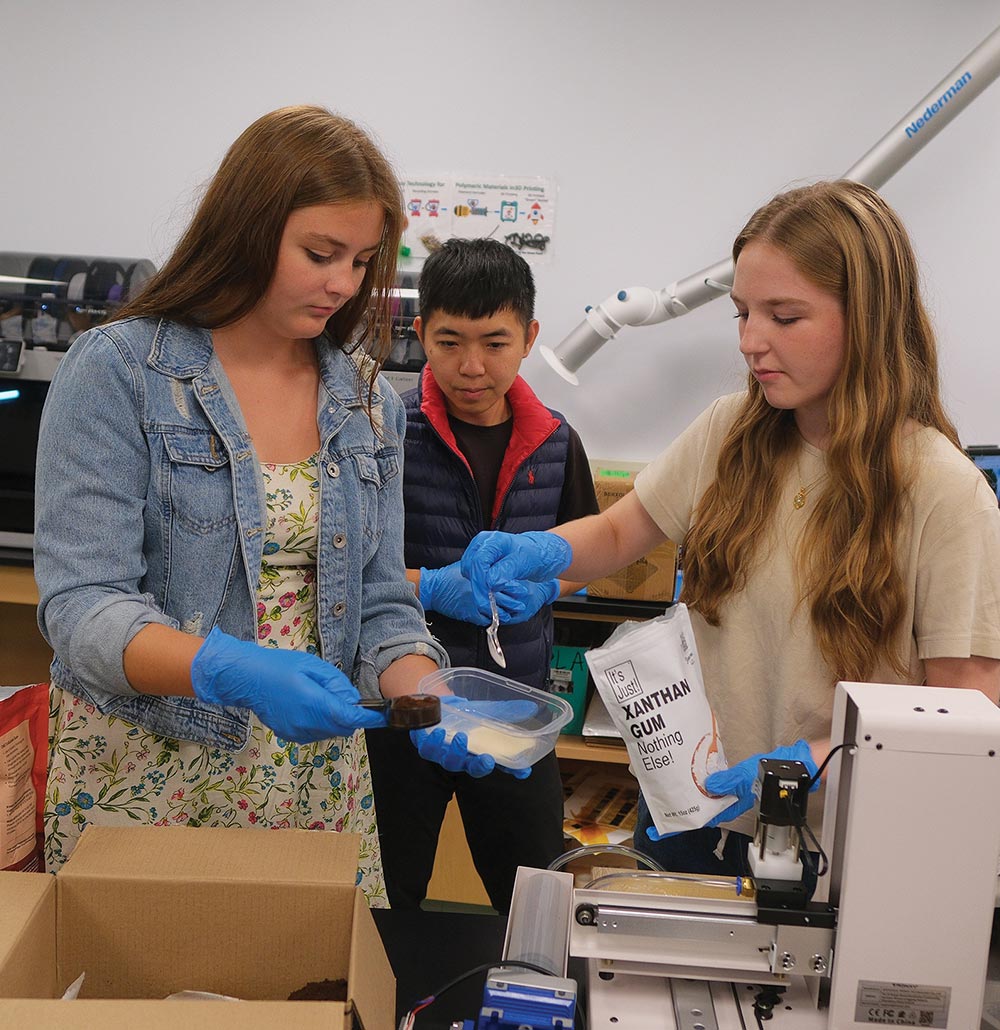

Foreground, Emilee Fields and Janey Parks mix xanthan gum with used coffee grounds to create a filament for 3D printers, under the direction of assistant professor Jheng-Wun Su (background).
5


Warming Up to Ideas
6
“That changed the trajectory of my entire life,” said Mickens, a junior mechanical engineering major from Masontown. “I love the problem-solving aspects of physics. I love learning the material within itself. I love watching how it is applied within the labs.
“I even started to catch myself looking at different wooden structures and trying to think about what calculations were made to build the truss and the internal or external stresses.”
Mickens began warming up to the idea of mechanical engineering, so it was fitting that he was interested when a friend and classmate introduced him to a project involving an experimental air heater.

Nicco Mickens works on the circuit board and electronic components of an air heater he built in the SRU lab.
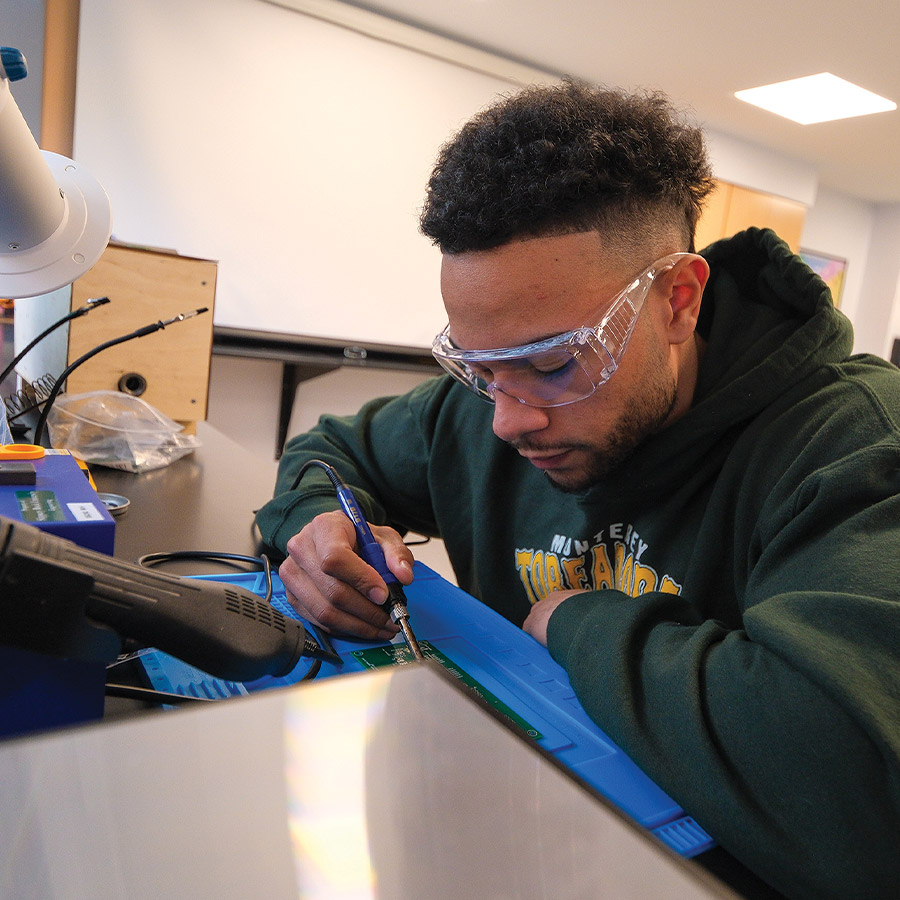
Under the advisement of Louis Christensen, assistant professor of engineering, Mickens is learning the optimal ways to transfer heat, which, from a physics perspective, is the same as cooling a system down.
“It’s just easier to watch things heat up because it’s easier to put a lot of hot air through something than put really, really, cold air through something,” Christensen said.
It’s also easier for students to learn through experiences in the lab than theories shared in the classroom.
“Hands-on learning is the best way to learn,” Mickens said. “I love seeing what works and what doesn’t and just having complete control over everything. Whenever I’m experiencing it all and applying the same principles from the class here in the lab, that’s a truly beneficial way to learn. I’ll know how to apply it later down the road.”
Future engineers will be tasked to solve the problems of tomorrow, whether that’s sustainably extracting rare earth minerals, building durable infrastructures or innovating manufacturing. That’s all down the road, but to get there, their paths start at SRU.
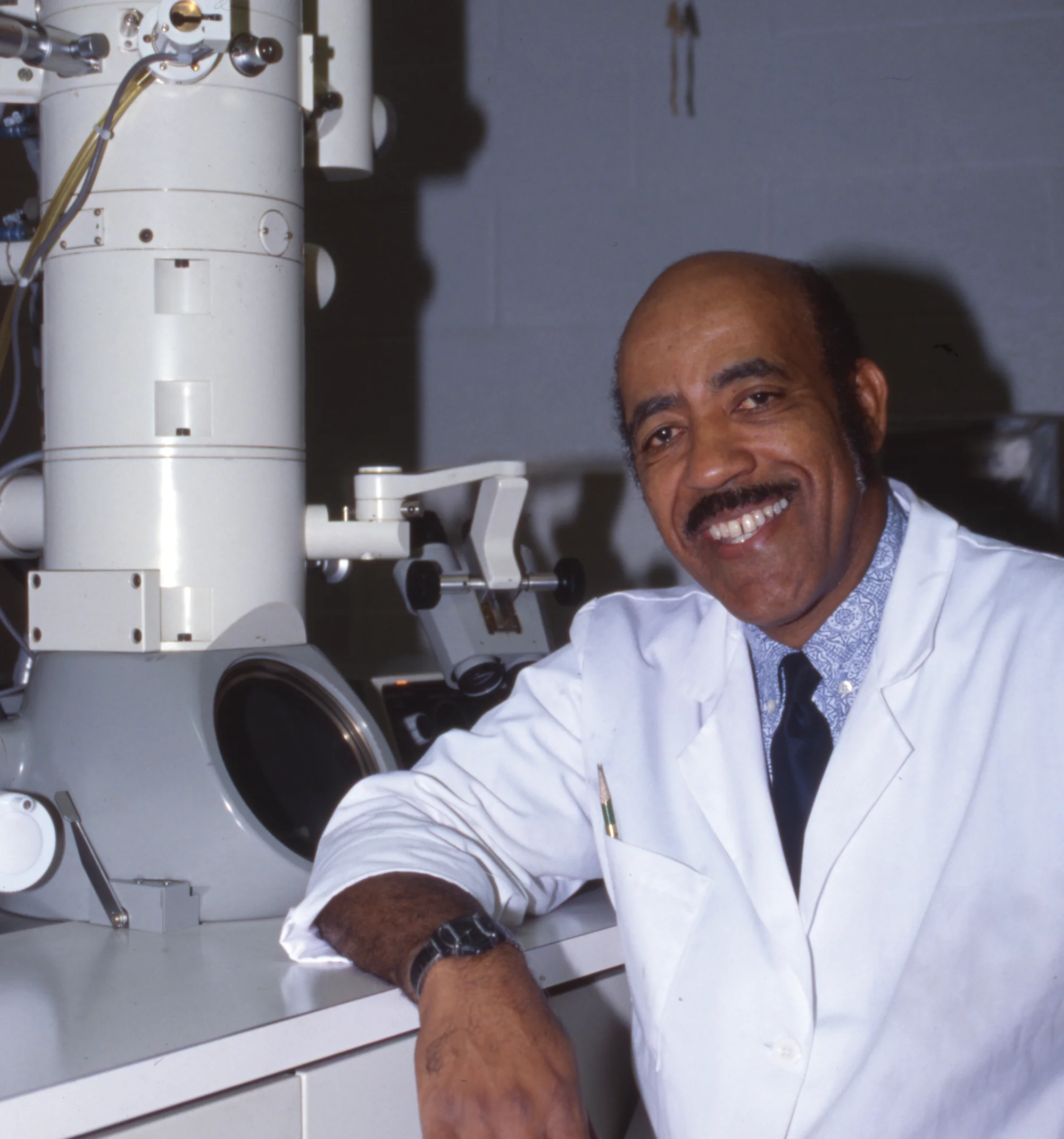
Thomas Gaither, who passed away Dec. 23, 2024, was an SRU faculty member for nearly four decades from 1968 to 2007.
Dichotomy of a Legacy
ew biology professors are interviewed by the likes of media luminaries Oprah Winfrey and Mike Wallace, let alone for something outside of their academic discipline. But Thomas Gaither was a sought-after speaker for his influence outside of the classroom, where he spent his entire career teaching biology at Slippery Rock University before retiring in 2007.
Prior to arriving at SRU in 1968, Gaither was one of the “Friendship Nine” civil rights activists who in 1961 conducted a lunch counter sit-in to protest South Carolina segregation laws. A member of the National Civil Rights Hall of Fame, Gaither received national recognition for his leadership, sharing stories from the civil rights movement and messages of nonviolence and hope. His speeches, letters and oral history are chronicled in the Library of Congress and the Smithsonian.
Gaither, 86, passed away Dec. 23, 2024, at his home in Prospect, not far from SRU’s campus where he impacted the lives of students who knew him almost entirely as an educator, rather than an activist.

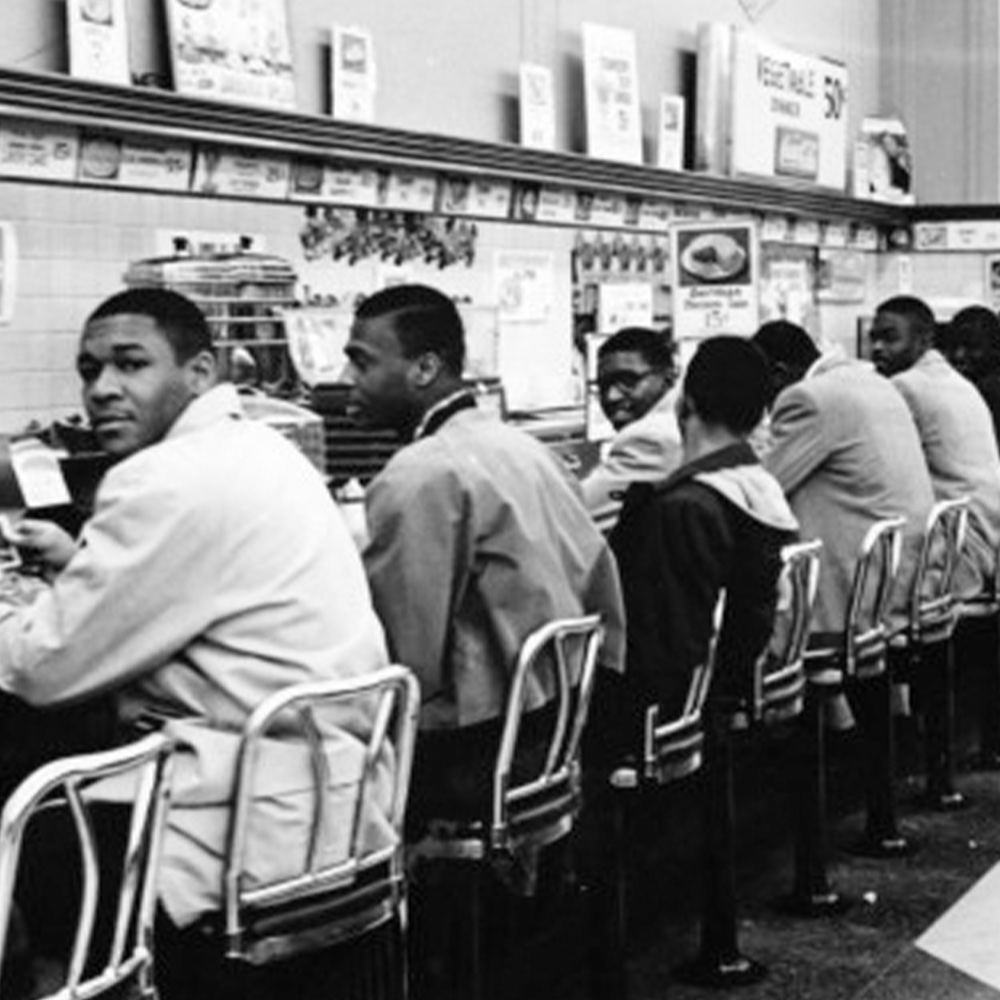
Gaither was among the famous ‘Friendship Nine’ who protested South Carolina segregation laws with lunch counter sit-ins.
Civil Rights and Justice
After he graduated in 1960, the 22-year-old Gaither was working as a field secretary for the Congress of Racial Equality. He recruited eight college students from Friendship Junior College in Rock Hill to order a hamburger, sit down and eat in the diner at the local McCrory’s five and dime store, which at the time was illegal for Black people. The nine men were handcuffed by police and thrown in jail, but rather than pay the $100 fine, the group chose hard labor on a chain gang, emphasizing the “jail, no bail” movement of the time that opposed giving money to governments that supported Jim Crow laws.
Gaither went on to earn a master’s degree from Clark Atlanta University and a doctoral degree from the University of Iowa, taking up a teaching career that led him to SRU where he started what he called his “first and only job.” He later referred to his work as a civil rights activist as simply “doing the right thing.”
“He believed so strongly in education; that was one of his deepest commitments and values.”
Students and Science
“He held high standards, and he pushed students, and sometimes they would push back,” said Kenn Gaither, who is now dean and professor of strategic communications at Elon University. “But many of those students who I’ve met years later would comment on how effective he was as a teacher, how much he cared about what he taught, and how enthusiastic he was about science. But as much as he was serious in the classroom, what made him a great father, he could be a lot of fun outside of the classroom.”
Family Fun and Flowers
“It became a running family joke, because he would furrow his brow and say that I knew what I was talking about,” Kenn said. “I finally told him, as he was close to dying, that I had been doing that from those notes.”
Kenn shared many other stories, including the time the family had a belly dancer enter his classroom to surprise him on his birthday, which would be completely unthinkable or acceptable to happen to a professor today, but Gaither, true to his form, continued teaching like nothing was different.
Later in his life, Gaither and his wife of 52 years, Diane, who died in 2021, were known for their flower gardens. Kenn marveled how his father would always refer to the flowers by their scientific names instead of roses or pansies.
SRU and Sports
“That’s something that bonded our family, because we still watch every Slippery Rock game,” Kenn Gaither said. “It actually gave me a great deal of comfort in his last few weeks when he would still get worked up over a missed tackle, because I saw a glimpse of my father as he was. He cheered on The Rock to the end.”
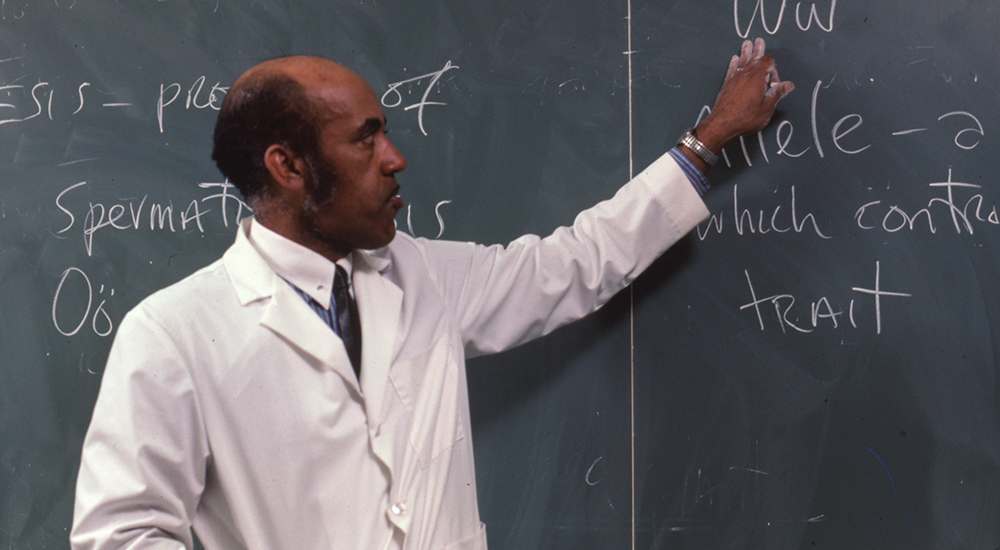
Continuing the Legacy
Elizabeth Brison, a freshman biology major from Washington, is the recipient of the latter. An advocate for people with disabilities, Brison comes from a low-income family and uses a service dog. She has an anxiety/depressive disorder, as well as psychologically induced cardiac disorder.
“I wouldn’t be here at Slippery Rock if not for this scholarship,” Brison said. “It’s paying for me to be a part of the University, so I’m very appreciative of that scholarship.”
Upon hearing this, Kenn smiled and his face welled up with pride.
“I know how much that would have meant to my father because he believed so strongly in education; that was one of his deepest commitments and values,” Kenn Gaither said. “He loved working with students, and he believed that education never betrays you. It always carries you further than you thought you could go or might go, and that’s what he saw in his students at Slippery Rock.”
For more information about supporting the Gaither scholarship, including a video with an interview with Gaither, visit www.srufoundation.org/gaither.
Ahead of the Game
sports isn’t all fun and games. It’s big business, a source for cultural and educational enrichment, an area of human performance science, and, for a professor at Slippery Rock University, a serious field for scholarly work.
Seth Jenny, an SRU associate professor of exercise science, is one of the leading global experts in esports education and curriculum design. He’s the senior editor of the first interdisciplinary textbooks about competitive video gaming, titled “Routledge Handbook of Esports,” released in fall of 2024.
The comprehensive 764-page text features 62 chapters and contributions from 93 authors across 27 countries. The book, which explores the rapid growth of esports within the sports and entertainment industries, covers 10 key themes, including esports research, esports business and management and global esports cultures, with Jenny co-authoring 17 chapters, nine as lead author and two as a solo author.
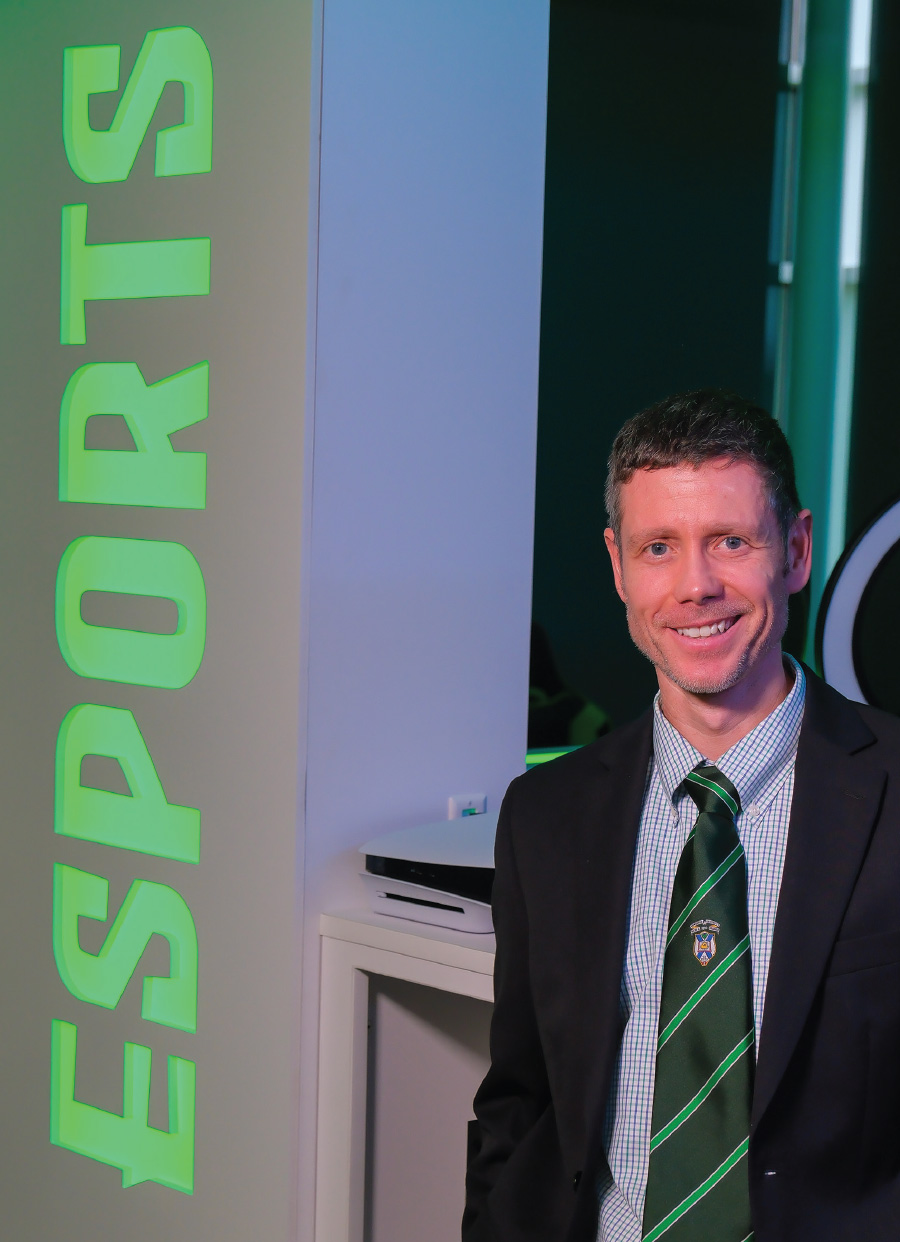
A 2002 SRU graduate and former captain of The Rock cross country and track and field teams, Jenny emerged as an esports researcher, not through computer science, but through health sciences. Since 2017, Jenny has taught in the Public Health and Exercise Science Departments at SRU. After earning his doctoral degree in physical education, sport and exercise science from the University of New Mexico, Jenny taught at UNM and Winthrop University and co-wrote the curriculum for the first undergraduate major in esports sports science at Shenandoah University.
“Esports is being used as a vehicle to help students learn so many different transferable skills.”
At SRU, Jenny is the faculty adviser to the Esports Club, one of the most active and popular student organizations on campus, and he teaches two required classes within SRU’s esports minor: Introduction to Esports and Current Issues in Esports, Health, and Society.
“What I’m teaching in my classes is performance and health related skills, but really esports is being used as a vehicle to help the students learn so many different transferable skills,” Jenny said. “I just love any type of instructional technology. And, really, I see esports as a way to teach human relations skills as well as hard skills. There’s hospitality and entertainment industries with event promotion, and with communication and media, with the broadcasting and streaming opportunities. It’s a motivational way for the students to continue to learn and for SRU to fulfill its mission.”

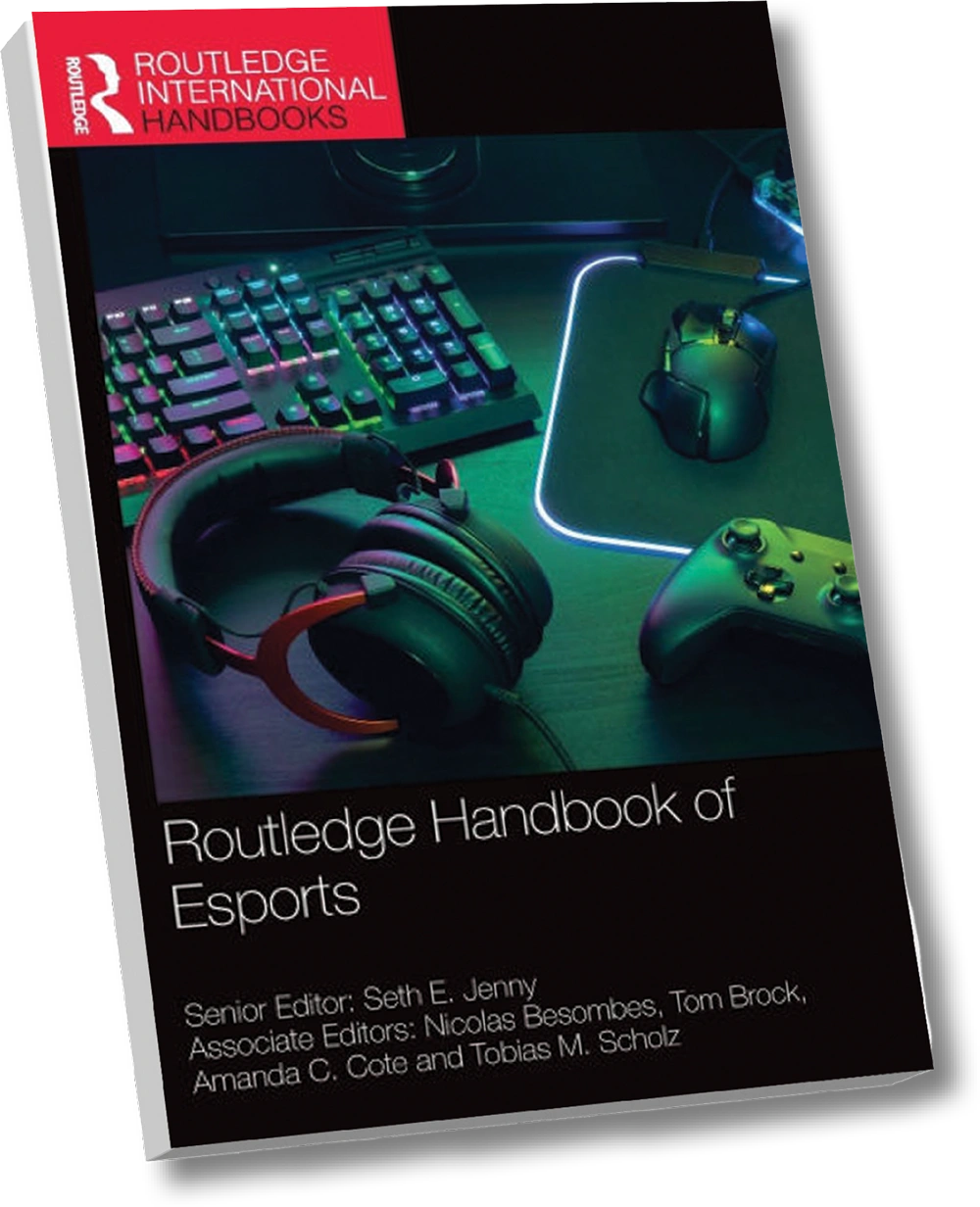
“Our University does a good job at looking at future trends and being proactive in making decisions to meet future needs in different career fields,” Jenny said. “SRU definitely has a mindset of keeping on top of current issues and trending careers.”
The global esports market size is expected to grow from $2.06 billion in 2024 to $9.29 billion by 2032, according to Forbes Business Insights, but other researchers claim that a more accurate estimation of the true market value are as much as $25 billion, including a study conducted by Jenny.
Jenny will continue to stay on top of the evolving esports industry.
“When I’m referencing and citing researchers in my own research, I know many of them personally,” Jenny said. “It is really fun to be able to cite people that you know in your own research and have other people cite you too. That is one thing that’s unique about esports research.”

Behind the Scenes
t’s easy to see and appreciate the performing art of a theater production at Slippery Rock University. All eyes are on the actors at a show. But behind the scenes is another world to experience. Contributors outside of the dozen or so cast members outnumber those on stage by about 2 to 1. And it’s not all technical work and following a script — there’s what Rebecca Morrice calls “creative problem-solving.”
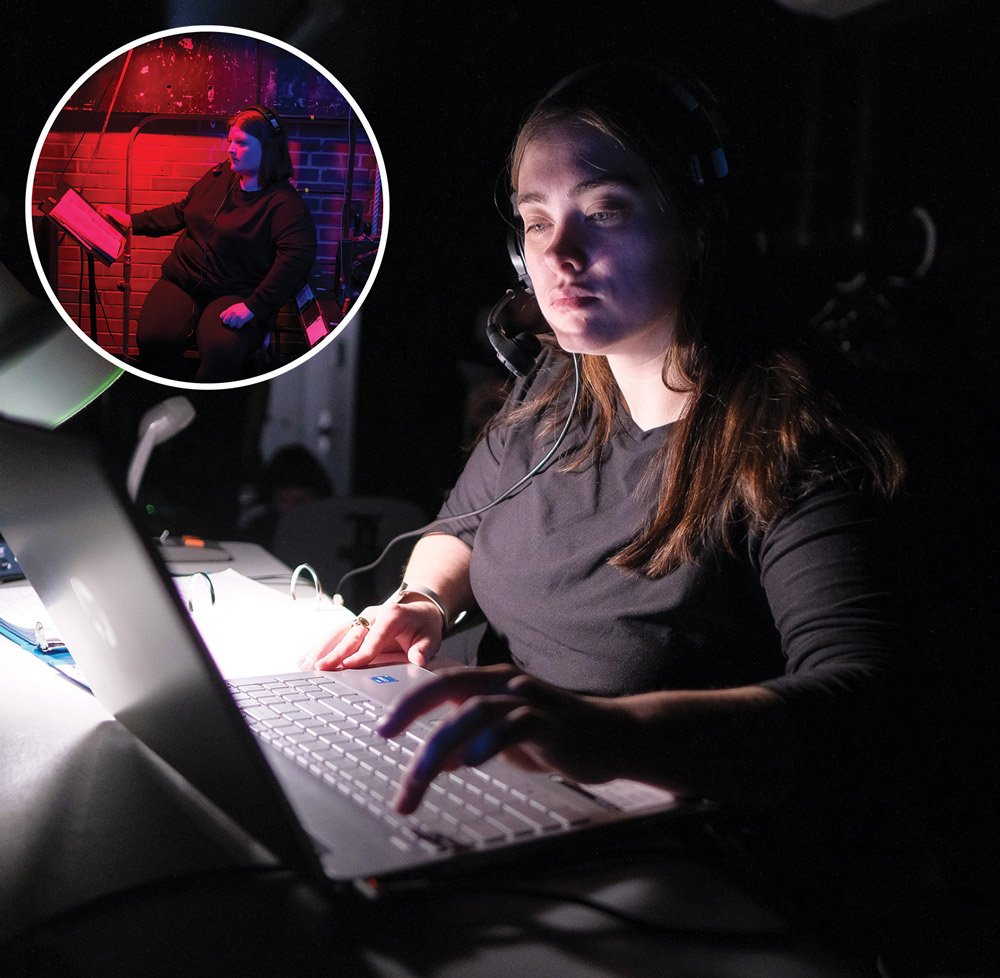
The SRU Theatre Department typically produces about four shows per academic year. In April 2025, SRU presented “The Curious Incident of the Dog in the Night-Time,” which was directed by Burton Tedesco, SRU assistant professor of theatre, and adapted from a popular 2003 mystery novel about a 15-year-old boy who is a brilliant mathematician with behavior difficulties and social challenges.
The story epitomizes how the cast and crew, comprised of students and some faculty and staff, must think like they’re solving a math problem but also be creative and unconstrained by the script, guidelines or expectations of the world. Like the boy, they make the story work for them.
Here’s a peek behind the curtain at some of the creative problem-solvers involved:
Stage Managers
Walsh is the main communicator, both in terms of preparing for the show and making sure the director, cast and designers are on the same page. But also during the show she is on the headset in the lighting booth in the back of the theater, calling sound, light and projection cues.
Starkey is stage right — for some shows there’s another assistant on stage left — and she is also on a headset with the blocking notes, which keeps track of the movements of cast and ensembles members: when and where they are entering and exiting the stage. She is also in charge of making sure that the props are in place and she directs two stage crew members who run backstage to set up costume changes and set transitions.
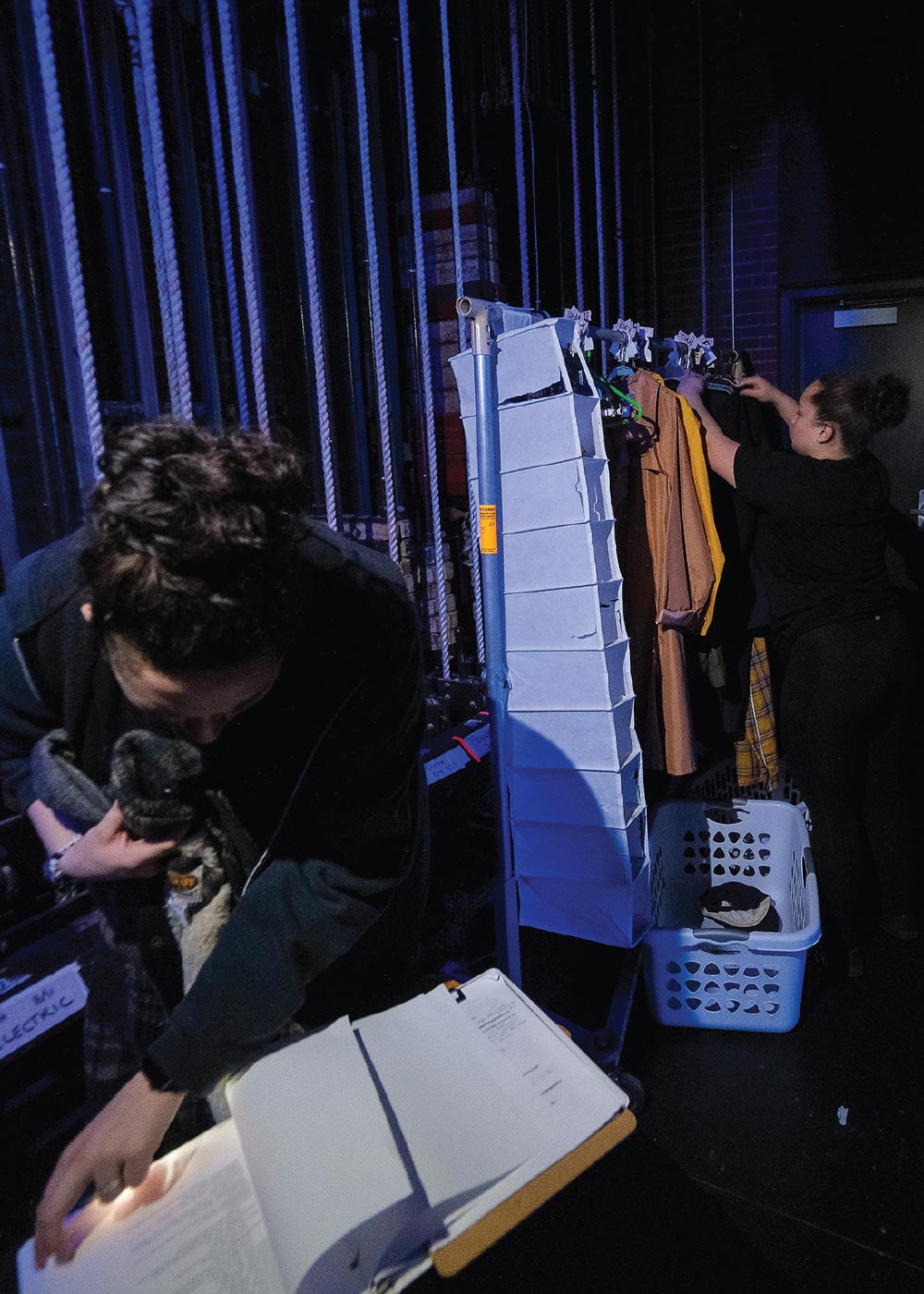
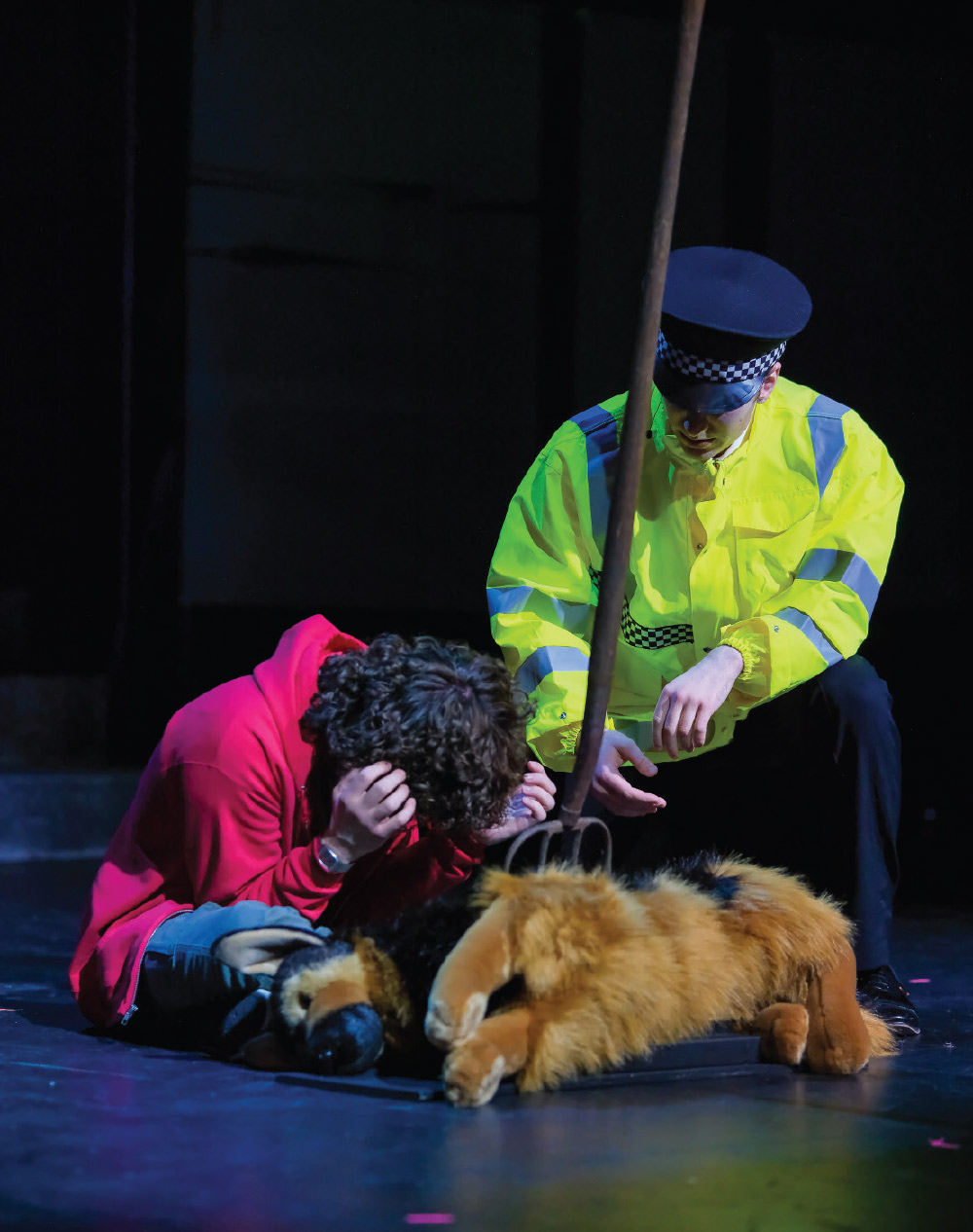
Propmaster
Costume Designers

The number of costumes varies per show, but each character in “The Curious Incident” had about 20 pieces maintained by Storms. There are 14 base costumes, but an actor might wear a different sweater or appear on stage as a different character, requiring a costume change.
Costumes for these productions are rarely rented or part of a predetermined outfit. Like the props, there’s searching stock, thrift stores and, of course, sewing and creating pieces in the costume shop on campus so that they properly fit each actor.

Lighting Designer
After days with long hours of meetings and rehearsals, Smith winds up with 130 lighting cues. His choices complement the larger story being told by the other contributors. Once the show begins, Smith’s work is done. The two spotlight operators and lighting board operator that he trained take their cues from Walsh, the stage manager in the booth.
Many Others
There are also swings and understudies, who take notes and follow the script the way a backup on a sports team must be ready in case the starter is injured. And that has happened: a cast member lost her voice last fall on the day of the show and an understudy had to step in and perform.
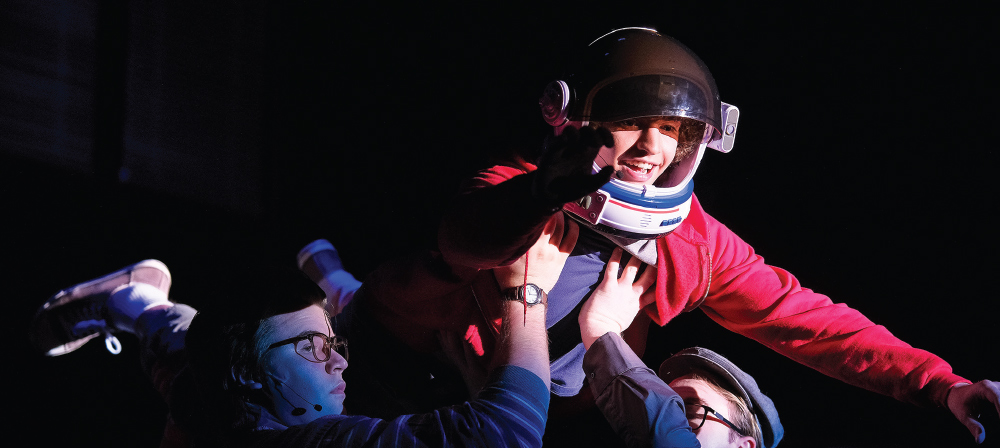
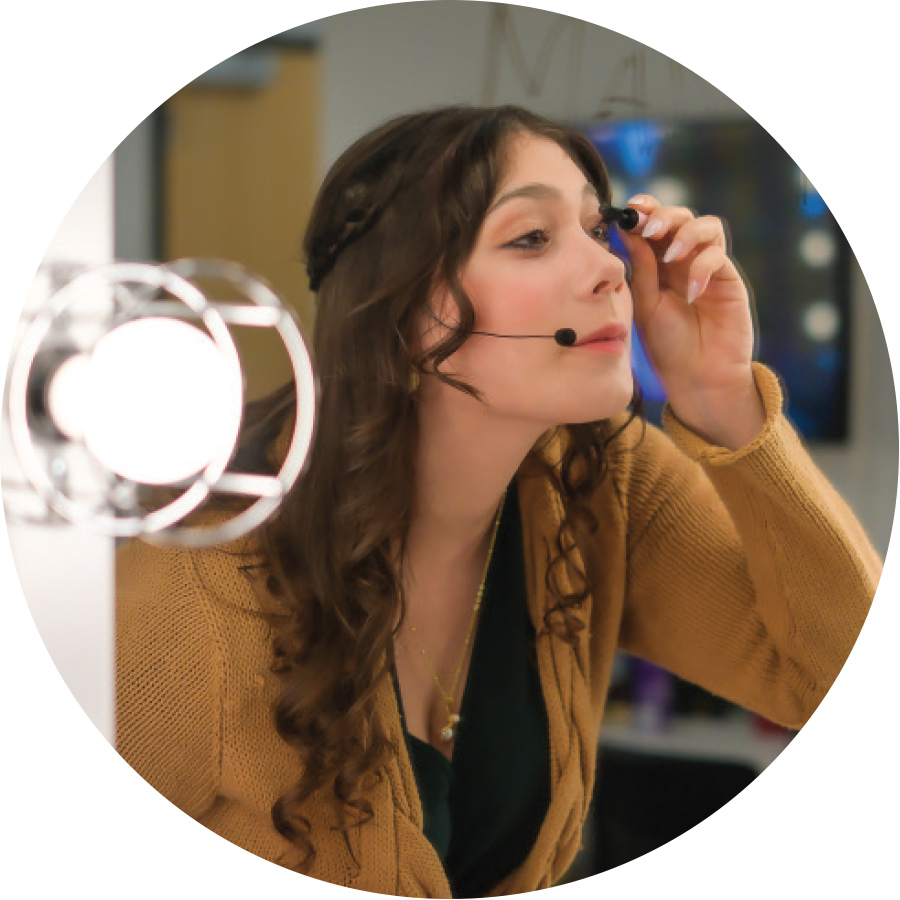
Culminating Effort
The experience students receive is much like what they would experience in a professional setting — that could mean working for a theater company or any workplace environment where problems are solved.
“Why are we bothering to tell these stories again and again?” Morrice said. “Because it’s how we get there. It’s the human connection that you’re making on the way. You can manufacture an experience in a classroom, but it doesn’t click until you actually get out here and do it. “It’s getting together a unique group of humans and creatively solving problems until we get to a final product.”
Memories Made on Graduation Day
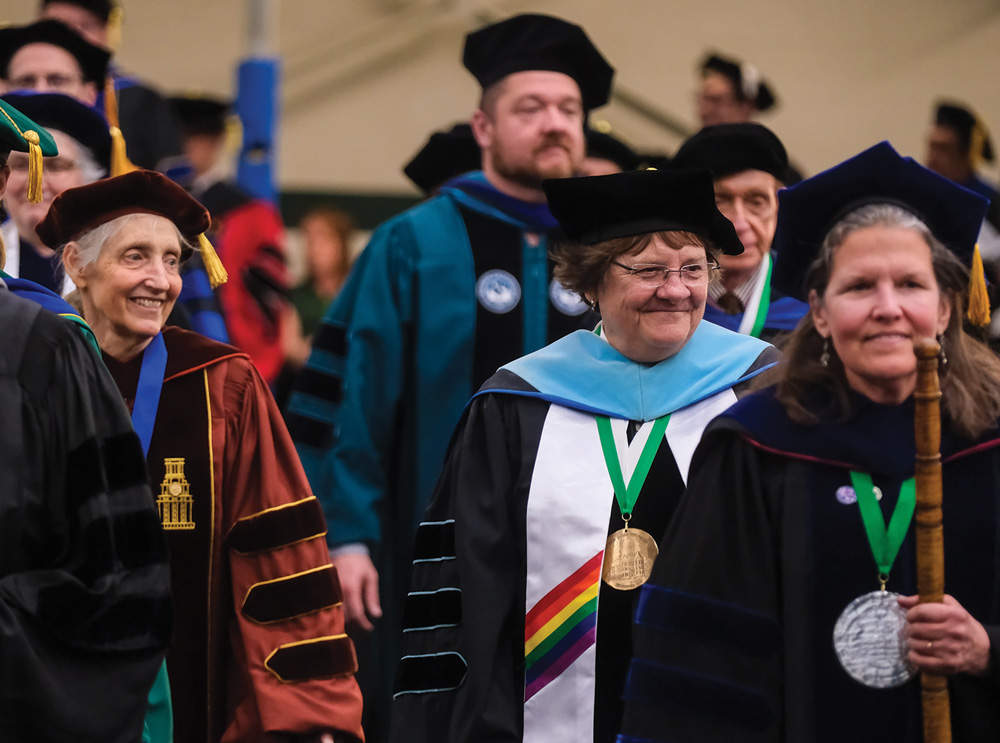
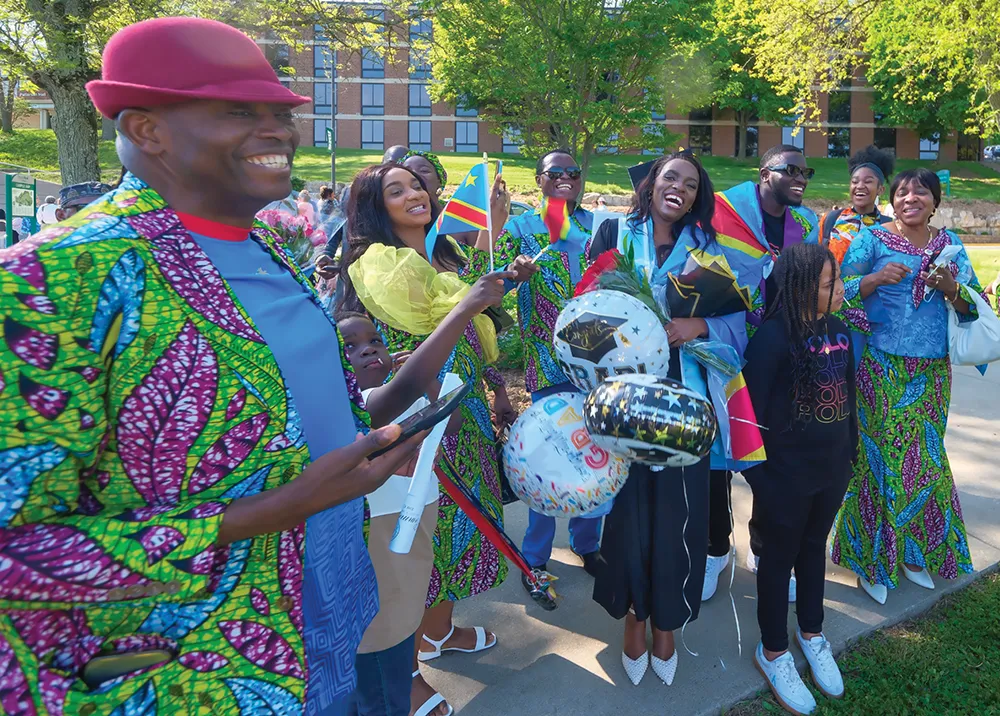
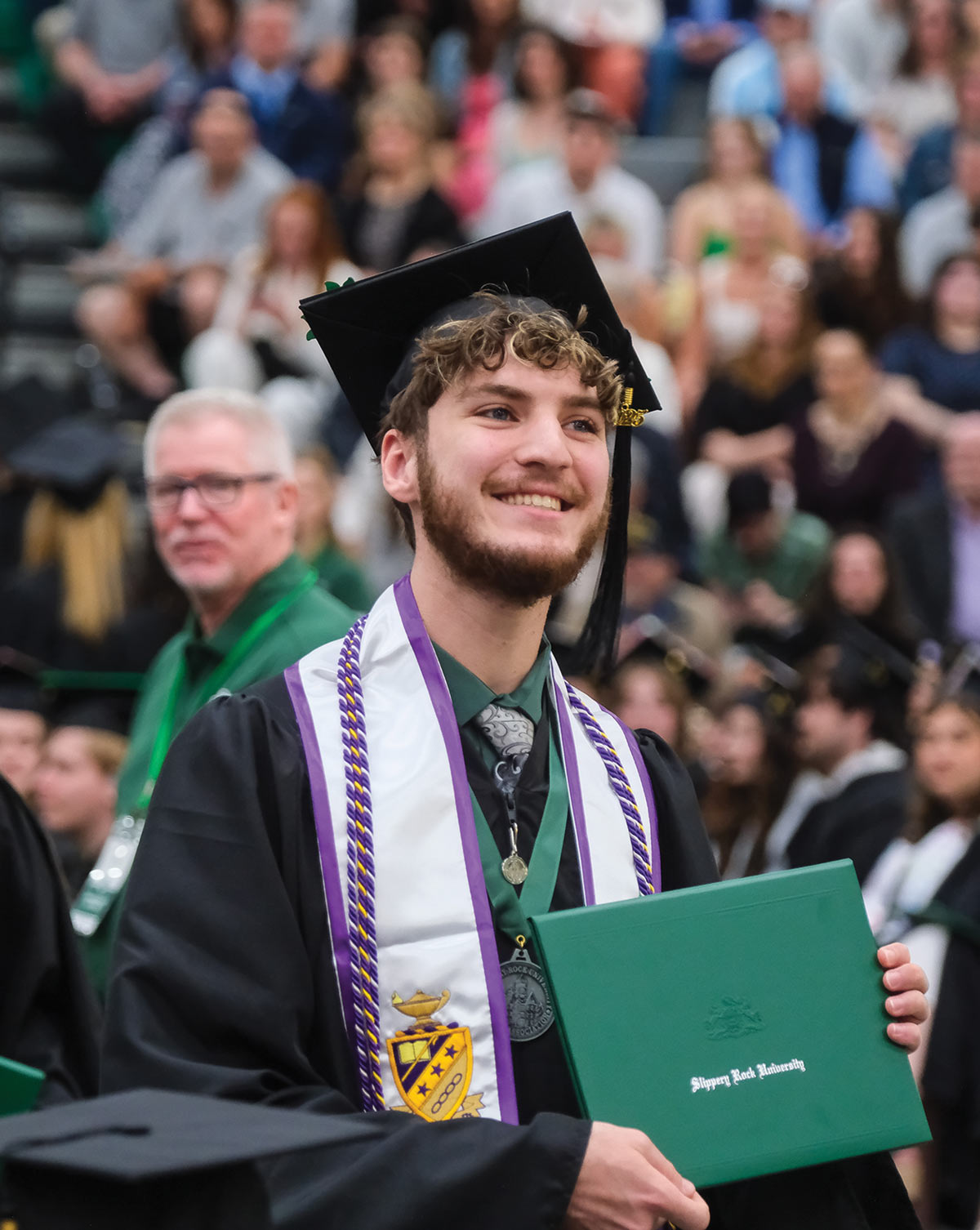
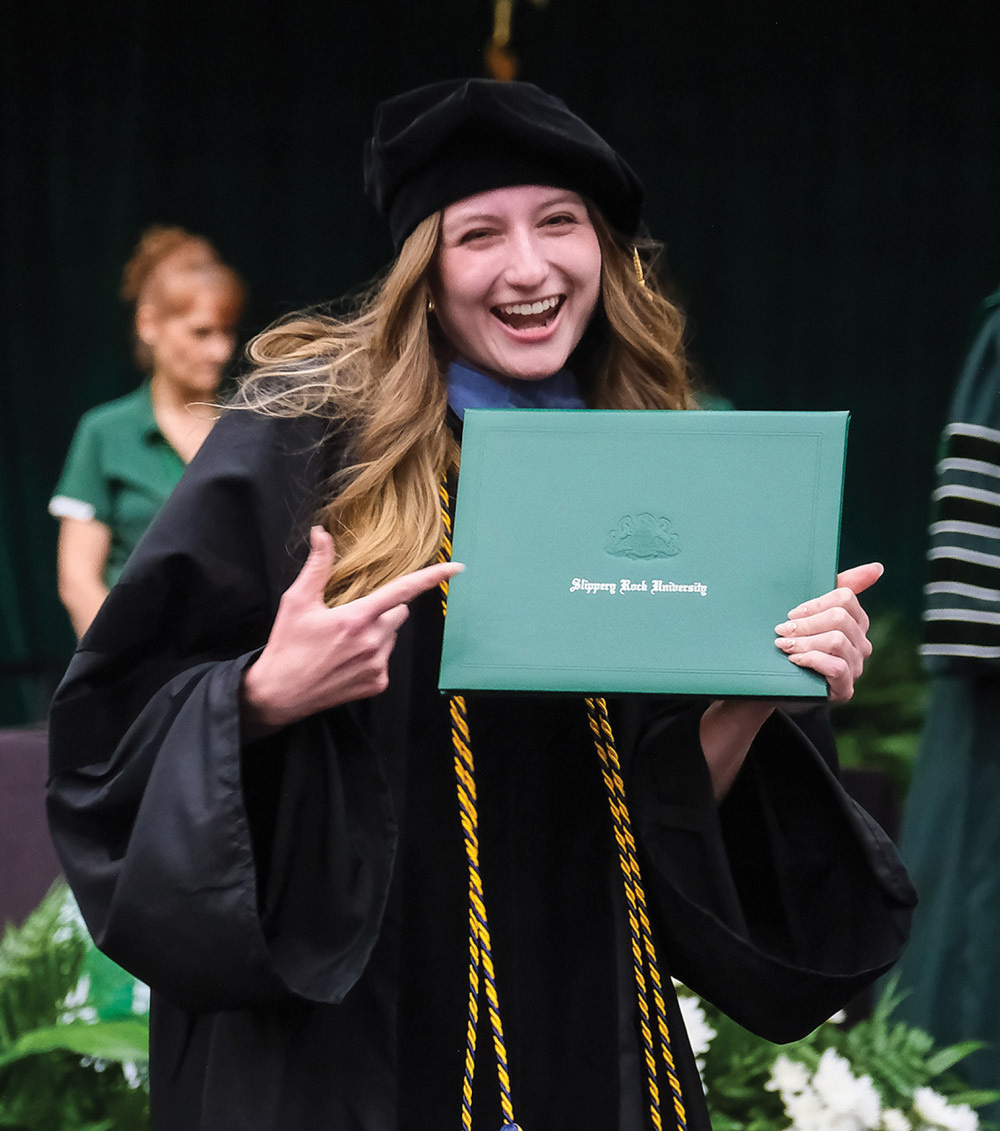
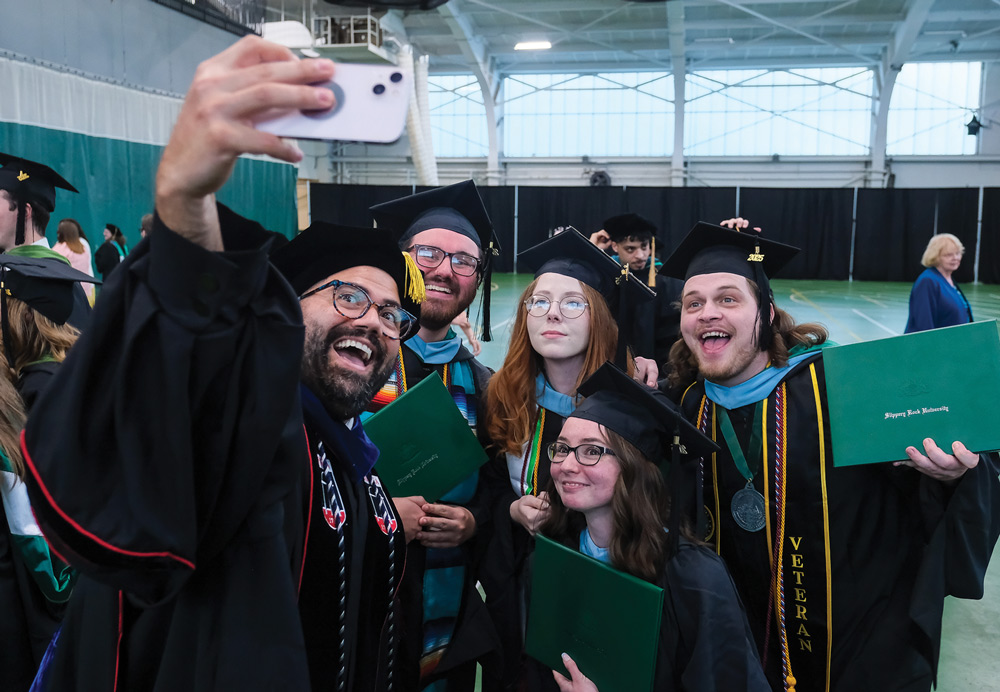
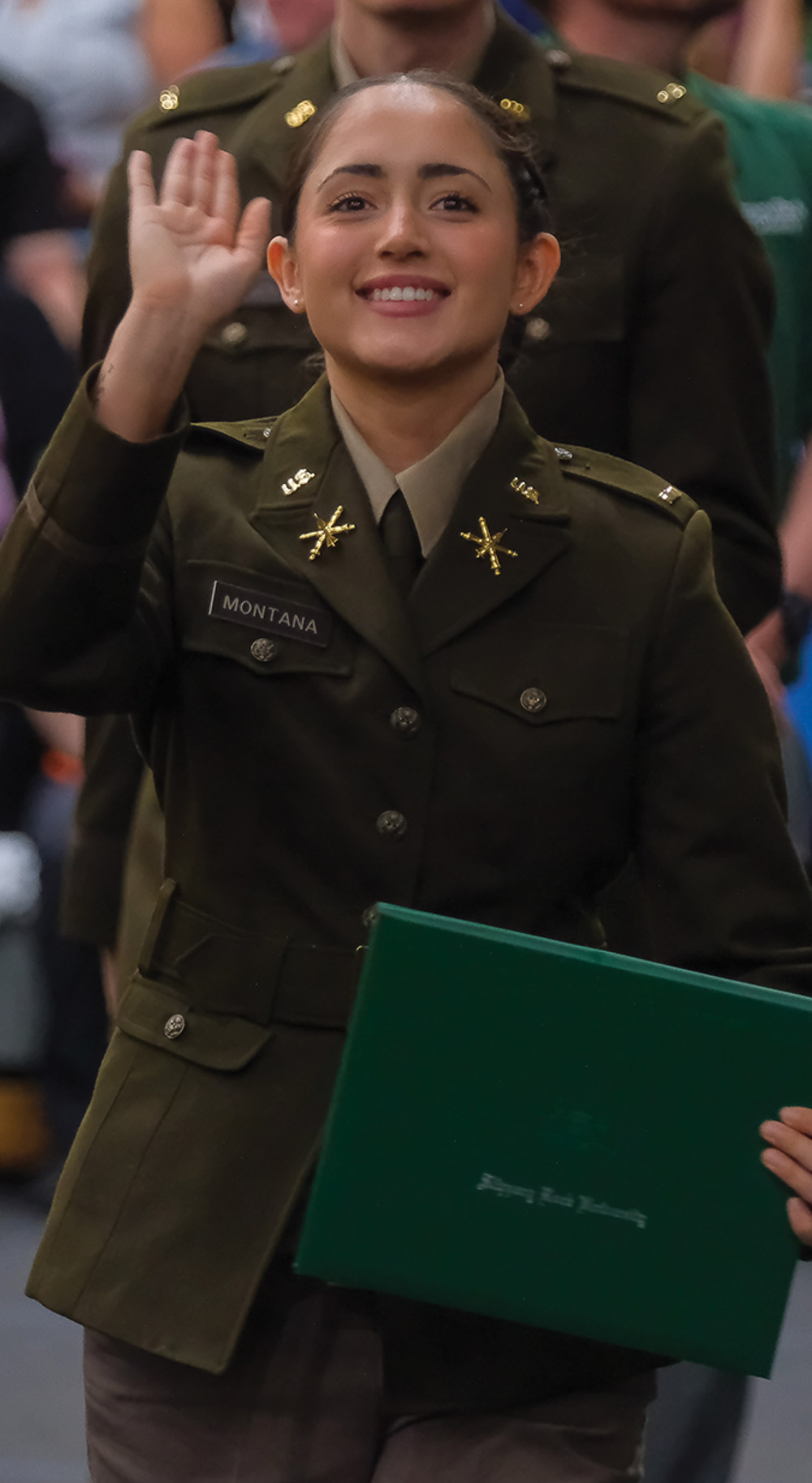

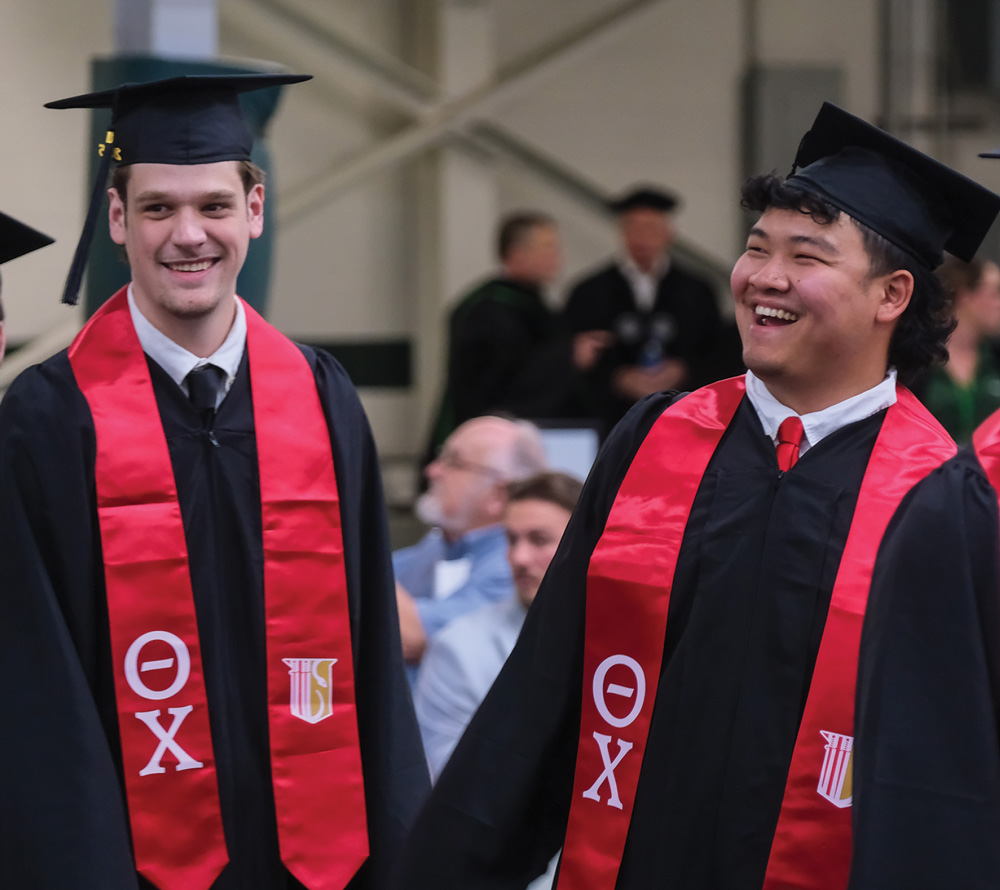
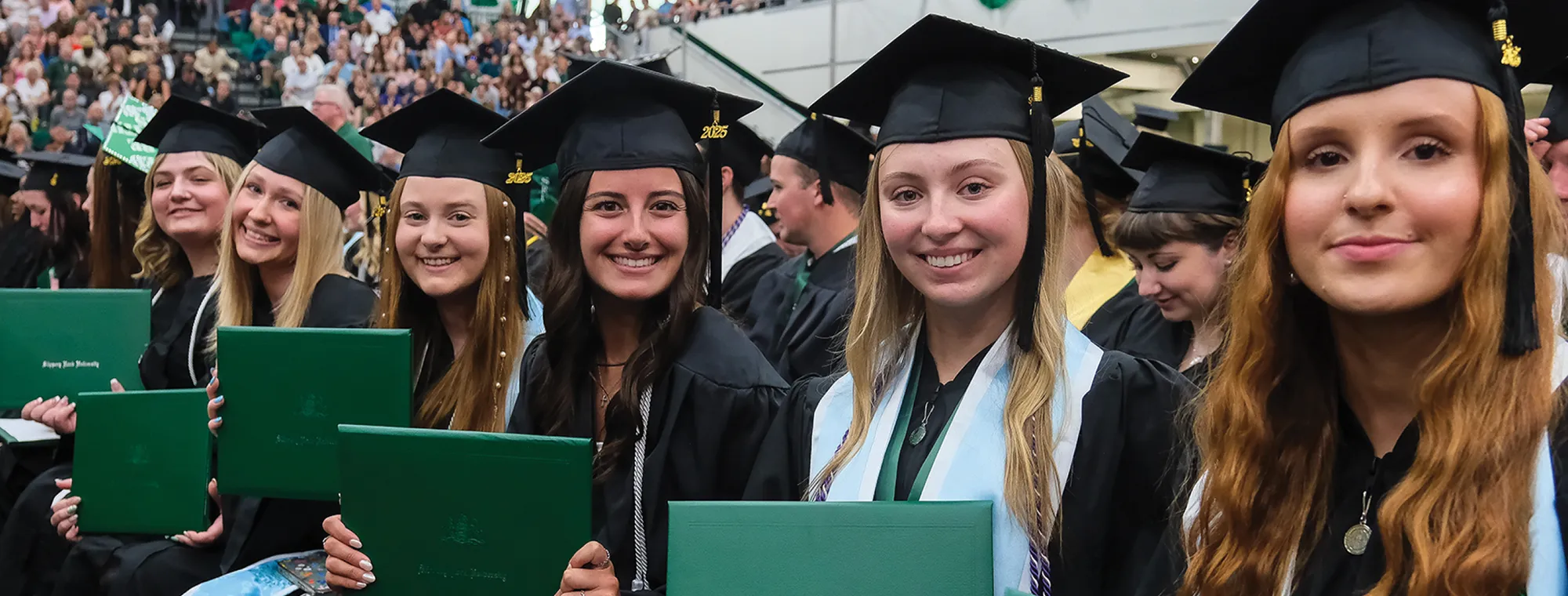
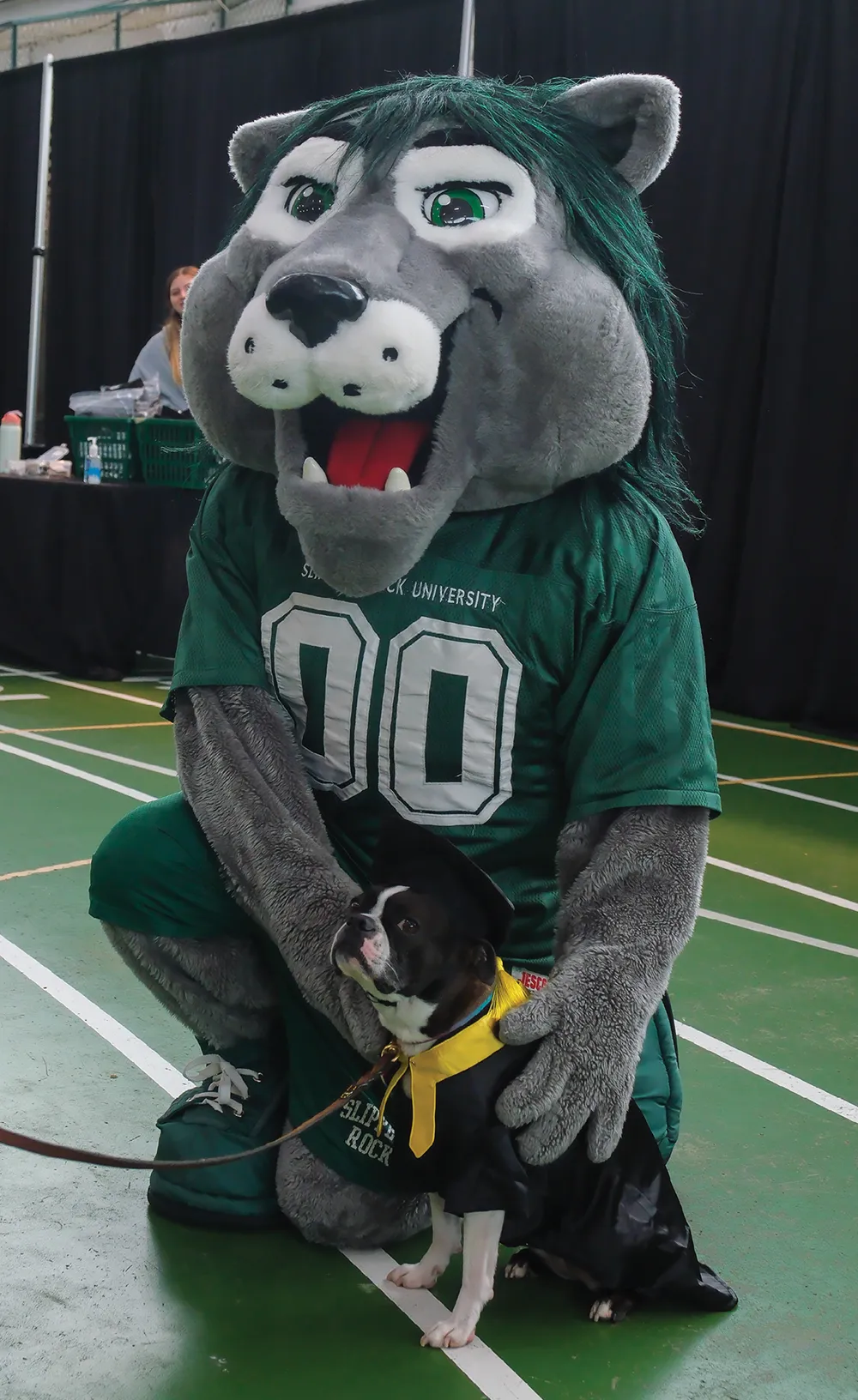
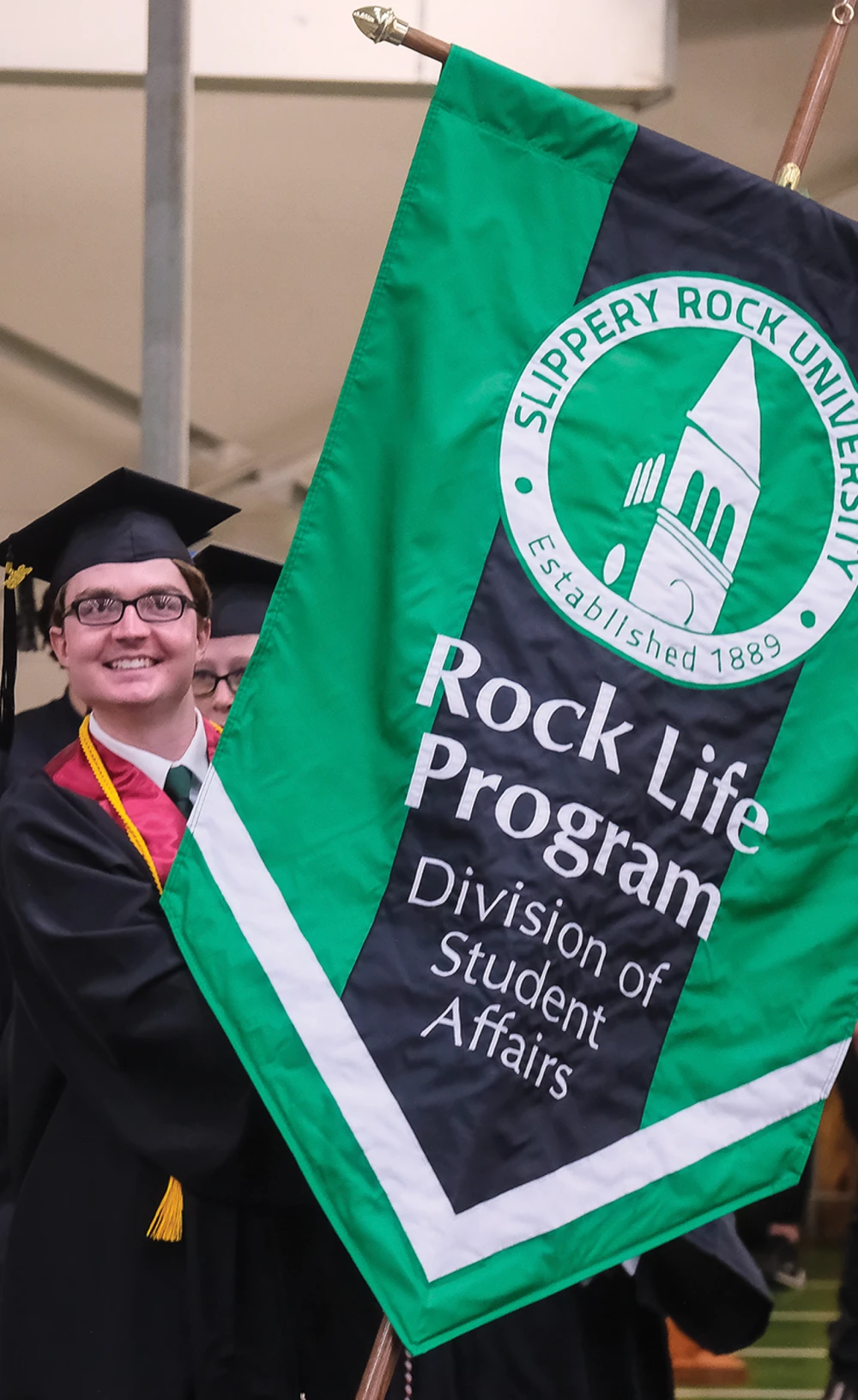
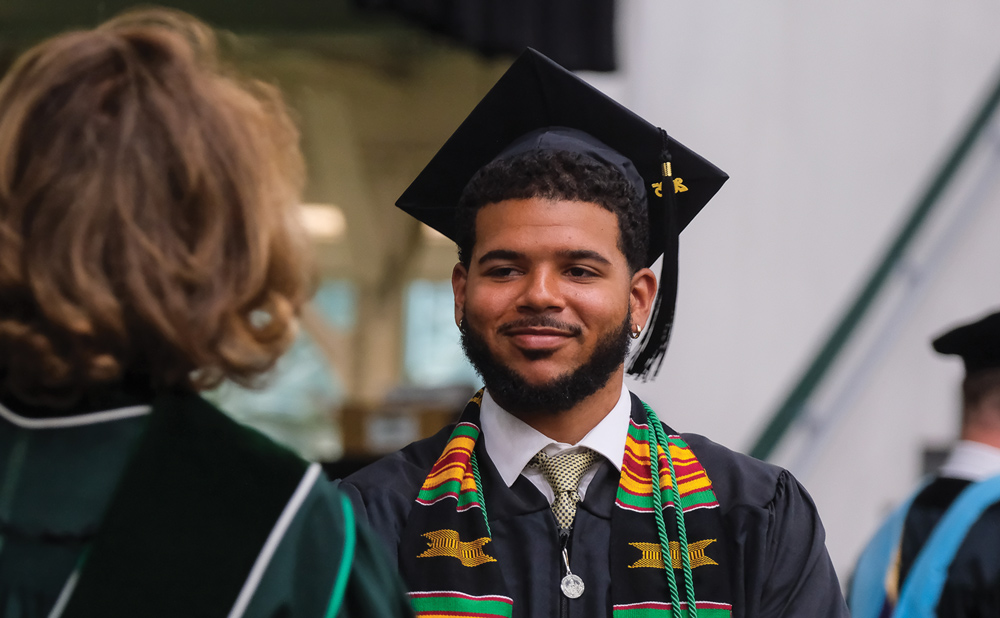
Q&A with Amanda Shotts-Habursky

Shotts-Habursky
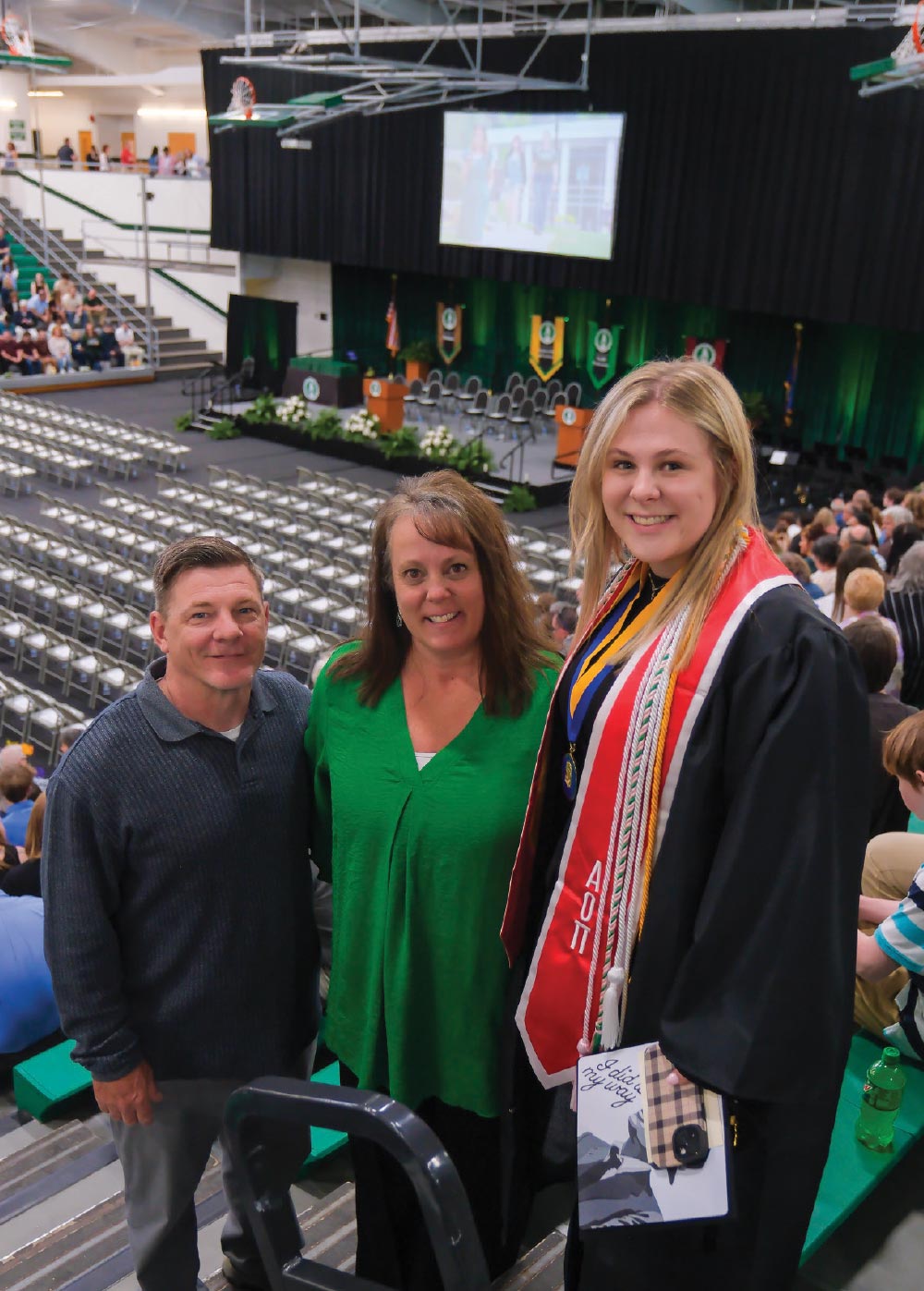
manda Shotts-Habursky’s daughter Mikayla is a 2025 graduate with a degree in political science. Her other daughter, Mariska, is joining the SRU community as a first-year student in fall 2025 majoring in exercise science.
Amanda is the focus of the first Parent’s Perspective column that looks at what it’s like raising children to take their steps into adulthood at The Rock.
First off, describe your daughter’s experience at SRU and what it’s been like for you?
What role did you play in your daughter’s decision to choose SRU?
What do you appreciate about SRU as a parent that maybe a student doesn’t as much?
What do you want other parents to know that you wish you knew four years ago?
The Long Game
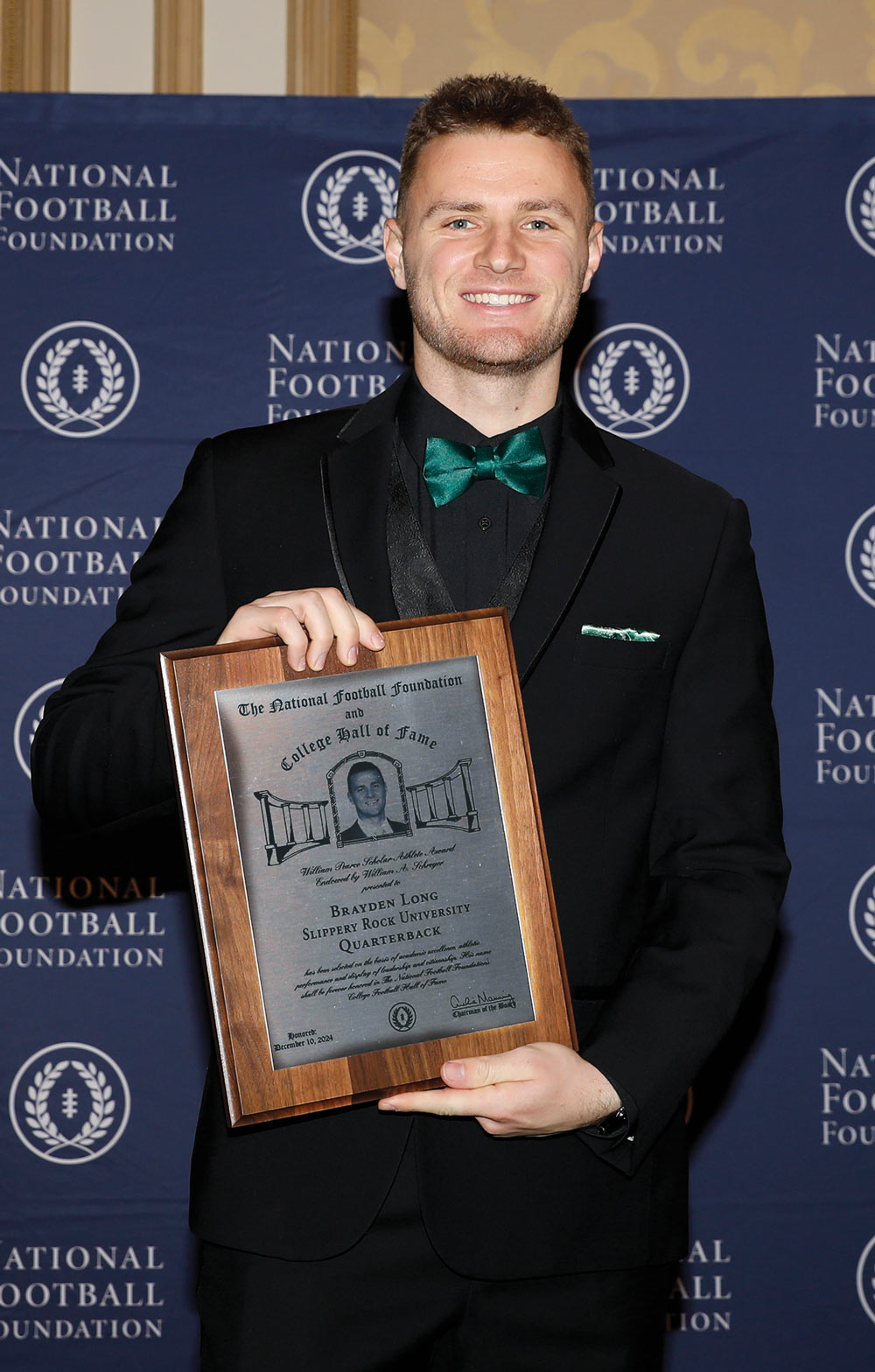
RU senior quarterback Brayden Long was celebrated as the top football student-athlete in NCAA Division II and was recognized for excellence on the field and in the classroom at a pair of black-tie events following the 2024 season. Long was the only football player from Division II to be named as a member of the 2024 National Scholar-Athlete Class by the National Football Foundation and College Hall of Fame. As one of the 16 national finalists for the William Campbell Trophy, he was recognized in December at the NFF Annual Awards Banquet and Hall of Fame induction ceremony at the Bellagio in Las Vegas.

Long established numerous passing records for his performance on the field and led SRU to the NCAA quarterfinals in 2023 and the national semifinals in 2024. Off the field, he graduated with a degree in sport management with a perfect 4.0 GPA. He has already began a career in coaching and is currently working with quarterbacks as an offensive analyst at Division I Towson University.
New Coaches
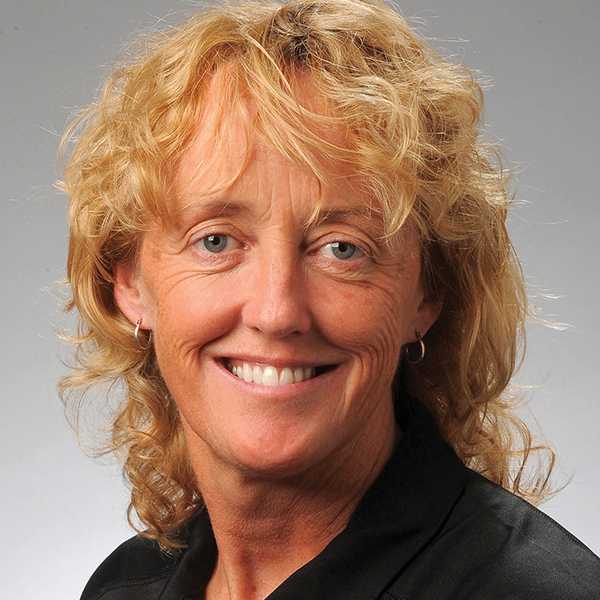



ESPN’s DJ
o middle school students at Pittsburgh Classical Academy, he’s Mr. Griffin — their music teacher. But after each week in the classroom during the fall, Mr. Griffin gets to preside over some of the most festive and raucous gatherings on college campuses all over the country. He’s there to play music and keep the tailgate-party atmosphere going in the background of ESPN’s popular football pregame show, College GameDay.

To college football fans, everywhere from Ann Arbor to Tuscaloosa, he’s DJ Griff. His real name is Ryan Griffin, a 2010 graduate of Slippery Rock University with a degree in music. And he laid down his first tracks as a music teacher and disc jockey while at SRU.
“I never imagined I’d get to do this in my wildest dreams,” Griffin said. “It’s hard to put into words the joy and excitement this GameDay gig brings me — traveling to all these states, cities and colleges. I got into DJing because I’m just a huge fan of fun. When I see a group of people dancing outside or at a club or an event, they’re having fun, and I really crave to be a part of that.”
Griffin’s job seems rather simple: show up on Saturday mornings at whichever campus ESPN GameDay is broadcasting from and play music for two hours before the show starts and between the commercial breaks. The live show airs from 9 a.m. to noon, Eastern time, and the fans play just as much of a role as the analysts. But there are nuances, instincts and even a bit of research that goes into it.
“There are students who have been there for 12 hours in the heat or the cold (to get a spot close to the stage to appear on TV) and you need to keep them as excited as they were when they first got there,” Griffin said. “It’s a big party, and they want to keep everyone as active and hyped up as possible.”
That might mean playing the perfect song for the moment or knowing which fanbases respond to certain anthems or chants.
“I spend a couple hours each week Googling and watching YouTube videos of in-stadium music to know what the crowd likes,” Griffin said. “You have to put yourself in the audience’s shoes, and think, ‘What would I want to hear right now?’”
It also helps to follow music trends, testing songs, and knowing what’s popular on college campuses. Griffin said “FE!N” by Travis Scott was a go-to song last fall.
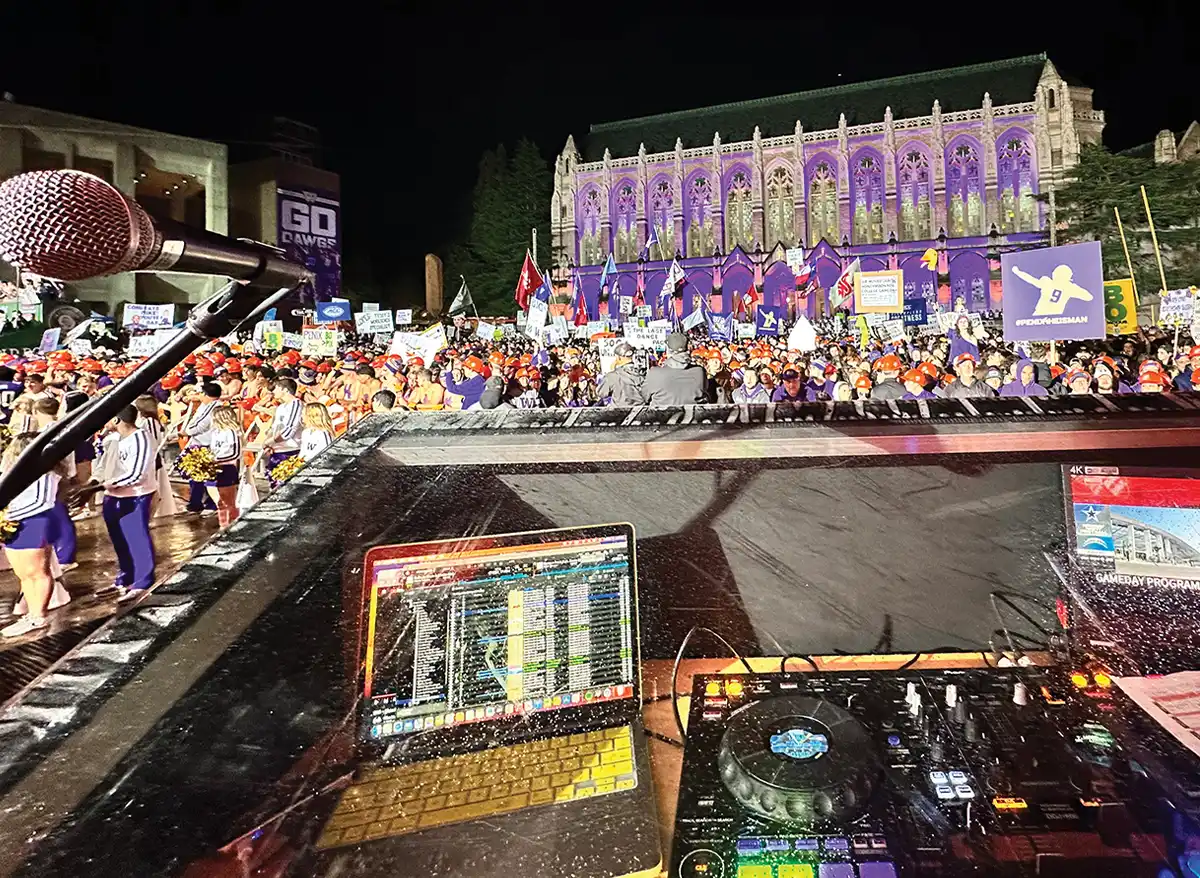
Griffin’s first experiences on college campuses and as a DJ was at SRU more than 15 years ago. To say he was active on SRU’s campus is an understatement. He performed in five music ensembles as an instrumentalist and vocalist, including the trumpet in the marching band. He was a member of Delta Chi and the Mu Phi Epsilon music honorary, he played on the ultimate frisbee club team, he refereed intramural sports, and he was a health center peer educator.
Too much campus involvement and his fandom for fun came at a cost. He overslept, underperformed and had misplaced his priorities. Griffin said his grades were terrible and he was nearly kicked out of the music education program for often not showing up for his field experiences. But through interventions from faculty and administrators like Mechelle and Stephen Hawk, Colleen Gray and even then president, Robert Smith, he was able to stay in the program and secure a student-teaching position.
“SRU gave me a second chance when I didn’t deserve one,” Griffin said. “I’m forever grateful to the school and the music and education departments and so many more. The second chance I got from SRU really taught me to be empathetic and kind — and to work harder.”
“I never imagined I’d get to do this in my wildest dreams … This journey started at Slippery Rock.”
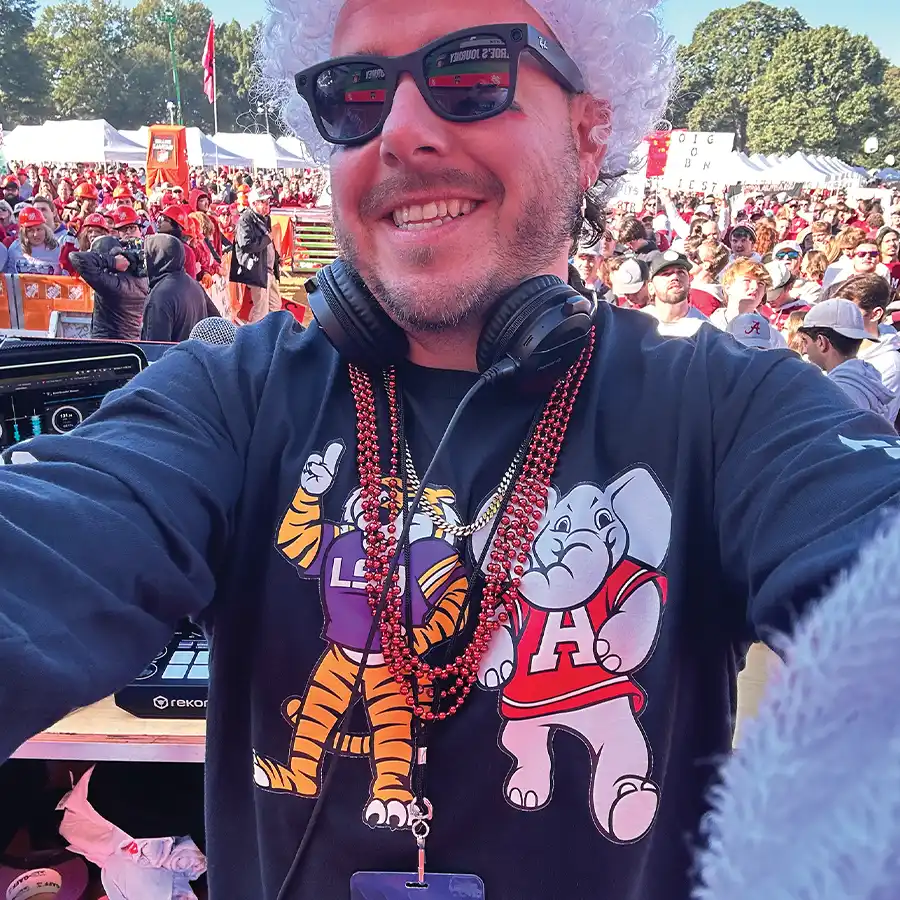
“I tried a lot of things and that got me doing weddings, and I just continued to get more comfortable,” Griffin said. “This journey started at Slippery Rock, whether it was the Music Department and the education program, or just wanting to have a good time playing music and making people happy.”

Griffin kept in touch with McAfee, who joined ESPN’s College GameDay as a full-time analyst in 2022. McAfee adds flair to the show as a hypeman himself, inciting the crowd with chants, singalongs and other histrionics, not to mention a field-goal kicking contest for charity. It makes sense for College GameDay to also have someone playing music, which it did until after the first week of the 2023 season when the previous DJ quit. Producers turned to McAfee for help.
“So about midway through the week, they had to find a new DJ,” Griffin said. “They were brainstorming and Pat’s like, ‘I know a guy. I can try him,’ and so he reached out to me. I’m forever indebted to Pat for thinking of me and advocating for me.”
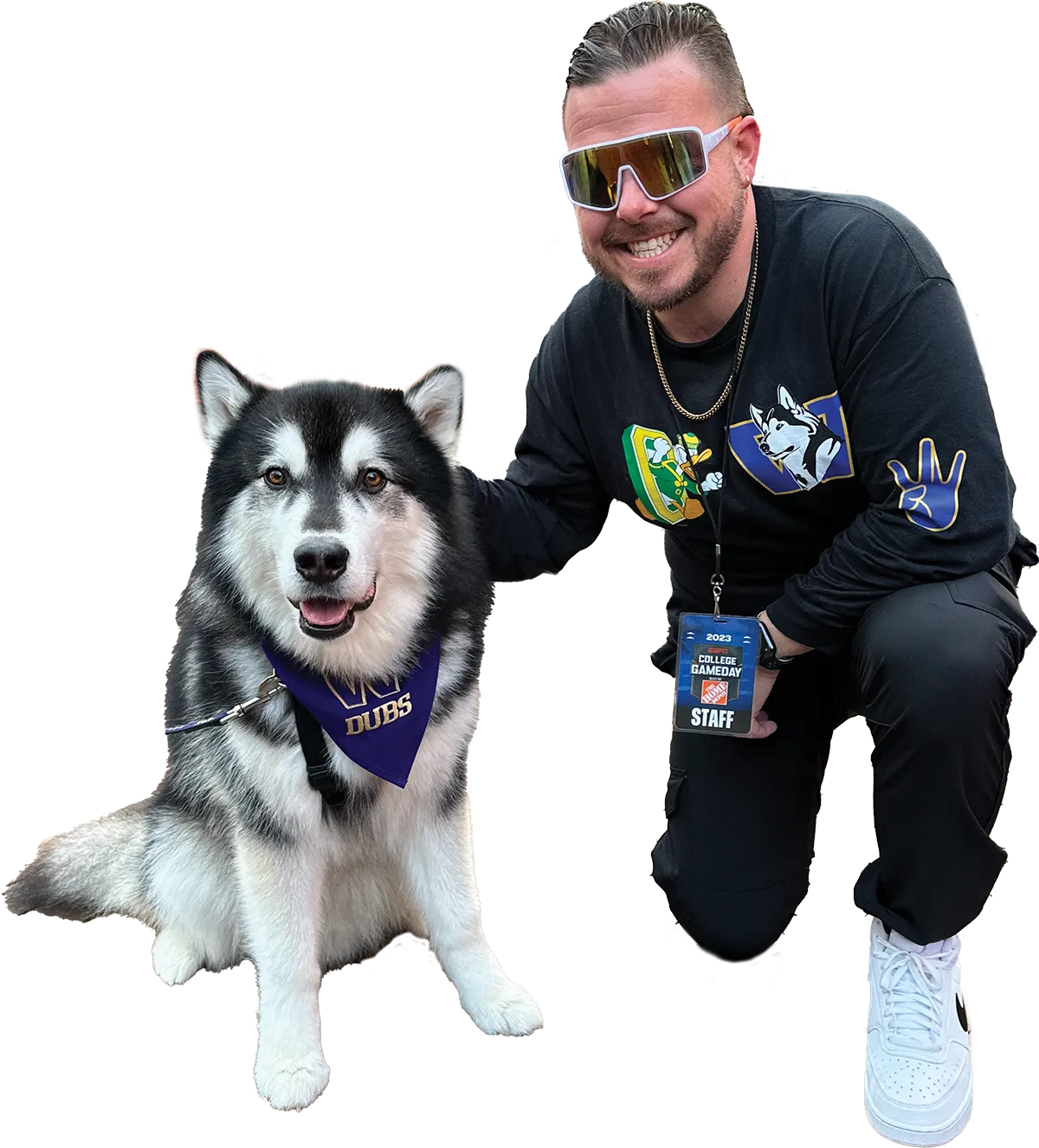
Griffin has gained notoriety and professional experiences with College GameDay, which has helped in both roles as DJ Griff and Mr. Griffin.
“Since I am a music teacher, I can relate some of the lessons to music production and I’ve gotten a few extra DJ gigs each year,” Griffin said. “My students are really interested; they’ll always ask me in class, ‘So where are you going this week?’”
Despite visiting all the big-time college campuses, Griffin has not forgotten about The Rock. SRU even comes to him. A group of SRU students from the sport management program work on the College GameDay when they visit Ohio State, Penn State and other nearby campuses. He’s occasionally recognized by other SRU alumni, even though he wears apparel representing that week’s home team.
“My favorite school is whatever school we’re at that Saturday,” Griffin said with a sheepish grin. “But people will often ask, ‘So where did you go?’ and I always proudly say Slippery Rock.”
Built on The Rock: Gary Charmel, ’86
fter a 37-year career in the beverage distribution business, Gary Charmel is raising a glass of his favorite bourbon for a retirement toast. Charmel, a 1986 Slippery Rock University graduate, retired earlier this year as a regional president for Johnson Brothers, a $3 billion wine, beer, and spirits distributor with more than 4,000 employees.

“It’s a fun business,” Charmel said. “There are more difficult things you can be doing than helping people celebrate life’s occasions with wine, spirits or beer. There’s the product aspect, the hospitality business, especially when you’re dealing with high-end restaurants and resorts in Las Vegas, but what I really enjoyed most is the relationships, mentoring and coaching and a lot that goes back to my sports background at Slippery Rock.”
Charmel played four years of football for The Rock under head coach Don Ault as a three-year all-conference offensive lineman. A native of Toms River, New Jersey, Charmel earned his degree from SRU in communication and entered the advertising business before he was hired by one of his clients, PepsiCo, leading to his career change.
“People gave me the opportunity to grow at Slippery Rock, whether that was the faculty or coaches,” Charmel said. “Football taught me that hard work does pay off, and, in the classroom, I learned that the world is your oyster if you’re willing to put the effort in and seek help from mentors. Especially in the communication program, I found my voice and I became a proficient writer and confident in public speaking.”
Even though he is retired, Charmel will continue to do consulting work and “lean into the coaching and mentoring on the executive level,” because that’s what he enjoys most.
“Who I am today was because people believed in me, not just from the things I did. Slippery Rock shaped me.”
“Now that I’m older and wiser, I realize a lot of who I am today is because people believed in me, not just from the things I did,” Charmel said. “Slippery Rock shaped me. I was a first-generation college student that came from a family that was blue collar and money was tight. That’s why I give. If you’ve had any measure of success, you should give because the baton has been passed to us now to be the ones who provide opportunities to younger folks and do the right thing.”
Instead of toasting to a successful career with a drink on the rocks, Charmel attributes his success to being at The Rock.
Do You Know These Rock Legends?
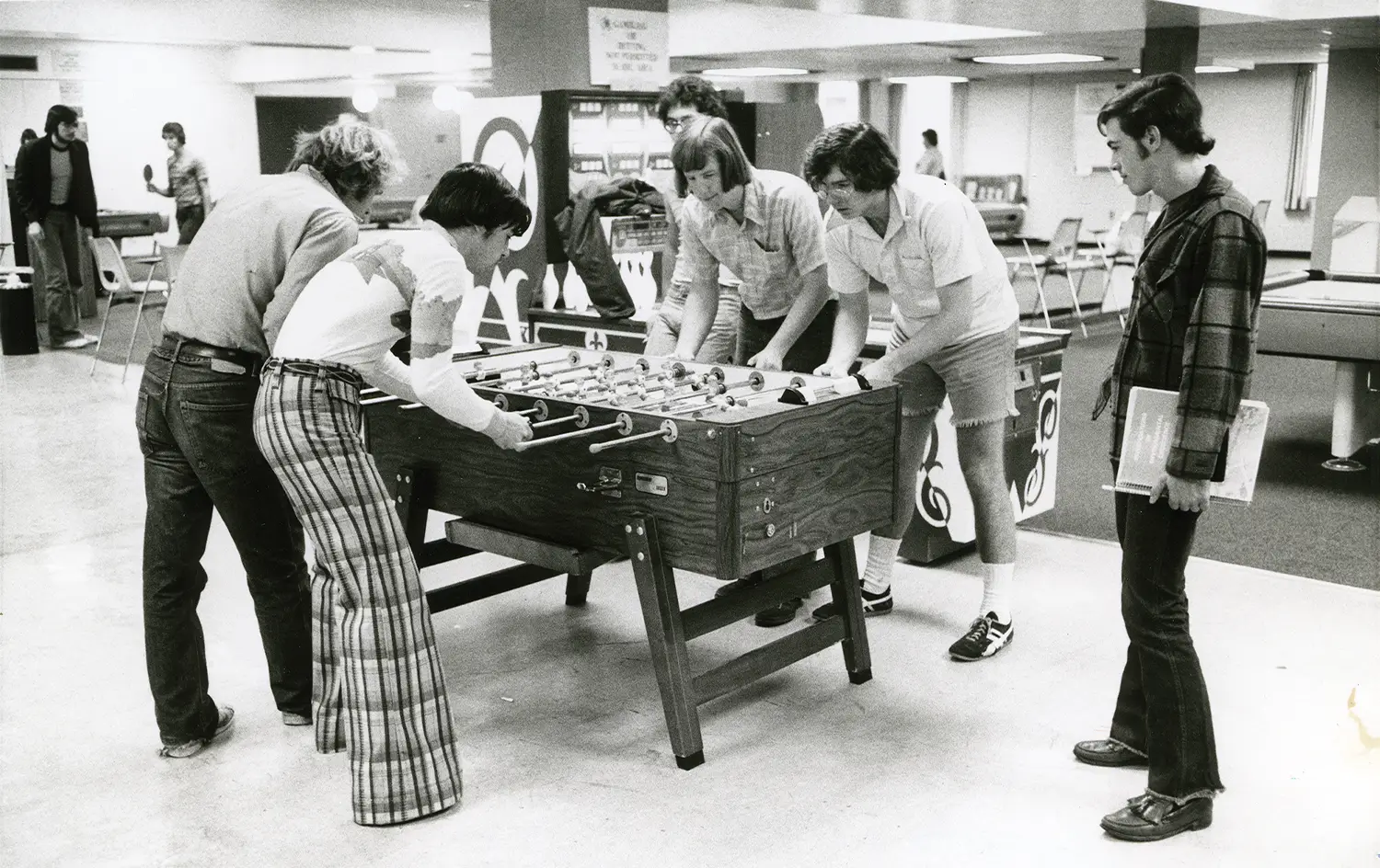
From the Archives: University Union
ow that SRU’s new Campus Success Center is open (see page 2), here’s a look at what previously occupied the renovated building, located at 103 Central Loop between Bailey Library and the Aebersold Recreation Center.
The University Union
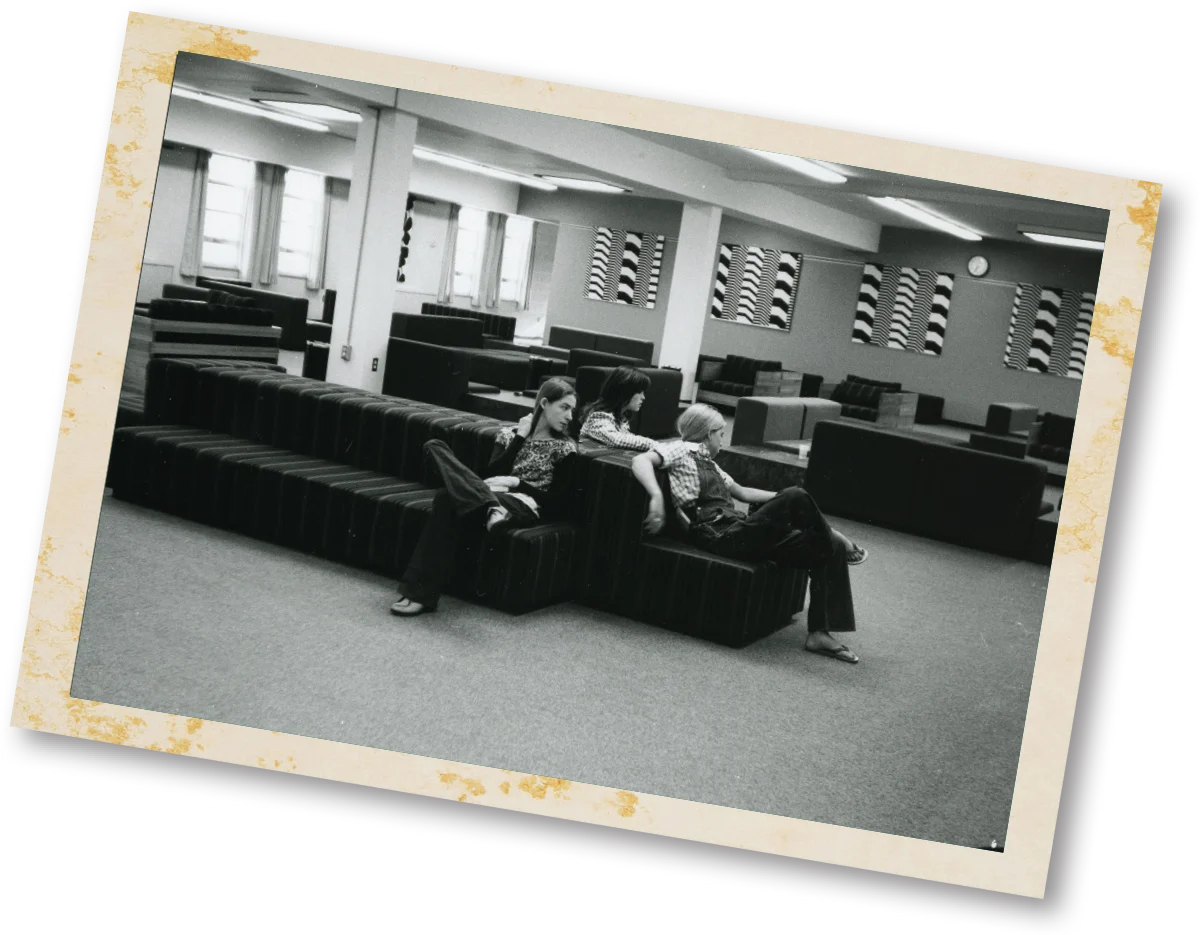
Class
Notes
-
1960s
Dick Hudson, ’68, was the guest speaker at the sold-out Mercer County Hall of Fame ceremony. Hudson, a 2011 inductee, achieved international acclaim through his work with the Olympic Games. Hudson was inducted into the SRU Sports Hall of Fame in 2006 and received the SRU Distinguished Alumni Award in 2010.


-
1970s
Kathy Tiernan, ’71, hosted the 48th annual Tiernan Family Turkey Bowl flag football game in Galveston, Texas, which featured a special guest, former Pittsburgh Steelers first round draft pick and Super Bowl champion Casey Hampton. Hampton played at Galveston Ball High School and the University of Texas. Tiernan sat next to Hampton on a flight from Houston to Pittsburgh and invited him to the game. Hampton surprised the family by showing up to play with Tiernan’s family members. An avid Steelers fan, Tiernan was born and raised in Oakmont where the Tiernan Turkey Bowl began.


- Robert Buzzinotti, ’72, wrote science fiction book titled “A Trip to Innsmouth and Other Places” that was published by Outskirts. Buzzinotti retired in 2008 after teaching for 31 years in the Armstrong School District.

- Anita (Osiecki) LaGrelius, ’72, has volunteered at the Warrior Games every year since 2018 including the Invictus Games in February 2025 in Vancouver, British Columbia, Canada.


- Sophia (Calaboyias) Facaros, ’74, was elected mayor of Oakmont, population 7,000, and home of the historic Oakmont Country Club that occasionally hosts the U.S. Open Golf Championship, including in the 125th annual U.S. Open in 2025. Facaros retired from Pittsburgh Public Schools after 38 years, finishing her career as principal of Schenley High School.

-
Janeice (Iole) Calfe, ’74, ’78M; Kyle (Derstine) Catanzarite, ’74; Linda (Rodgers) Watson, ’74; Mary Lou (Pracht) Seamon, ’74; and Marilyn (Murphy) Cagnoli, ’74, celebrated their 50th anniversary as SRU graduates and great friends. They met as freshmen and have remained in touch over the years, meeting annually in various cities and resorts for 3-4 days of reminiscing and lots of laughter.


- Gary Neely, ’77, was awarded Butler County Veteran of the Year, which has been awarded annually since 1979 and is a collaboration between the Butler County Veterans Committee and the office of Pennsylvania State Rep. Marci Mustello (R-11th). Neely was a machine-gunner for the U.S. Marine Corps in Vietnam, serving two tours in Vietnam from 1967-68, and again from 1971-72 as a crew chief and door gunner. Neely received three Purple Heart medals and seven Air Medals for combat missions.

- Robert Tomko, ’78, and Darcy (Gualardo) Tomko, ’79, will celebrate their 46th wedding anniversary in August 2025. The couple has two children and six grandchildren. Since retiring to Carolina Shores, North Carolina, they continue to enjoy golfing, the beach, traveling and participating in SRU’s Rockin’ Carolinas Alumni events.


-
1980s
Eileen (Flinn) Dusch, ’83, and Lynn (Hadvab) Ferguson, ’85, former Tri Sigma sorority sisters, hiked the Camino de Santiago in Spain from Sarria to Santiago, concluding at the Praza da Quintana.


- Jennifer Aubel, ’84, was inducted into the Virginia High School Hall of Fame. Aubel was recognized for her outstanding contributions as a gymnastics coach.

- Karen Frazier, ’84, and her son, Wally Wolanin, ’10, saw a familiar sign at the head waters of the Mississippi River in northern Minnesota.


- Tim Allen, ’85, recently retired after 35 years of service in law enforcement, including 28 years with the Rhode Island State Police. In his last position, Allen served as a captain and was a command staff member overseeing the Professional Standards Unit. Throughout his career, Allen held various roles within the Detective Division, including assignments in the High-Intensity Drug Trafficking Unit, Violent Fugitive Task Force, Gang Unit, Organized Crime/Intelligence Unit, and Gaming Enforcement Unit. His wife, Jacquelyn (Quigley) Allen, ’85, is a registered nurse in the Endoscopy Unit at Women & Infants Hospital. They have three adult children: TJ, Brittany, and Jarret.

- Mark “Razz” Radziewicz, ’85, was honored by The Pennsylvania Association of Broadcasters for his feature, “Toby Keith: A Country Life,” receiving the Outstanding Radio Feature Story/Report/Series award. Radziewicz wrote and narrated the piece taking listeners on an emotional journey through the legendary country artist’s life, music and influence on the industry. Radziewicz was also ranked No. 8 as one of Barrett Media’s Top 20 Program Directors in Country in 2024.

- Lee Whitted, ’88, and his wife, Dequita, celebrated 25 years of marriage. Whitted was promoted to director of social work in a Silver Spring, Maryland, nursing facility.

- Darin Powell, ’89, was presented the Lifesaving & Meritorious Action Award from the Caddo Area Council-Boy Scouts of America in recognition of his courage and heroism. Powell sprang into action during a Texas A&M–Texarkana baseball game when gunfire rang out and a bullet struck an 18-year-old near the bullpen. Powell provided critical care until emergency responders arrived. As a certified athletic trainer and physical therapist assistant, Powell has dedicated his career to the well-being of others. In Scouting, he has been a leader, mentor and role model, serving in Cub Scouts, Troops, Venturing, and as an OA Lodge Adviser. His commitment was recognized in 2021 when he received the Silver Beaver Award, one of Scouting’s highest honors.

Medal of Merit:
Has performed an act of service of a rare or exceptional character that reflects an uncommon degree of concern for the well-being of others.
-
1990s
Anthony Casamo, ’96, joined Williamson Health Medical Group in Franklin, Tennessee, as a board-certified physician assistant, specializing in general neurology with Williamson Health Medical Group.
- Christy (Brown) Nemeth, ’96, and her husband, Neil, celebrated 28 years of marriage.


- Krista (Zinz) Wolfe ,’99,’22 DPT, was elected to serve on the board of directors for the Federation of State Boards of Physical Therapy. Wolfe will help guide the Federation’s strategic initiatives and ensure that operations align with its mission. Wolfe is Central Penn College’s Vice President of Academic Affairs and Provost.


-
2000s
Marianne Biangone, ’01, was inducted as a Fellow in the American Academy of Nursing, as one of 3,400 nurses around the world with this designation. The Academy, which represents accomplished nursing leaders in policy, research, administration, practice and academia, is a policy think tank of nursing experts. Biangone began serving as the associate dean of education programs at the University of California, San Francisco, in January 2025.


- Paul Miller, ’03, received his Ph.D. in communications media and instructional technology from Indiana University of Pennsylvania last fall. Miller’s dissertation, titled “Cinematic Celebrations: Understanding Family Holiday Practices Through Christmas Movie Consumption,” chronicled the traditional use of holiday-themed films by parents and their children. Miller presented his dissertation research at last March’s annual Popular Culture Association National Conference in Chicago.

- Emily (Fury) Mazzant, ’09, ’12M, ’21D, was appointed as assistant professor of special education at Westminster College’s School of Education. She currently teaches courses in behavior management and high- and low-incidence strategies and provides observation and assessment for PreK-12 students. Mazzant also holds a Wilson Dyslexia Practitioner certification from Drexel University.

- Courtney Caughey-Stambul, ’09, was elected to the board of Animal Charity of Ohio, the only humane society in Mahoning County, Ohio. Caughey-Stambul has been volunteering with the nonprofit organization for the last two years and hopes to continue to make a positive difference in the lives of animals.


- Ryan Reagle, ’09, was appointed principal of Woodland Elementary School in the Onslow County School district.

- Lori Sykes, ’05, earned her Ed.D. from Wilmington University in organizational leadership, learning and innovation. Sykes’s research focused on the effects of the impostor phenomenon in professional Black women. Sykes is a technical trainer at KTMC, LLP, and an adjunct professor at Eastern University.

-
2010s
Matthew Morgan, ’14, wrote a book titled “Annie the Anxious Pug” published by IngramSpark and available on Amazon. The book, written from the perspective of Annie the Pug, addresses anxiety as a daily stressor that, when compounded, can be a challenge, and Annie presents ways to recognize and manage those emotions.

-
Jamaur Law, ’13, and Xzavier Moye, ’11, (from left, holding flag) shared their experiences and advice while meeting with 17 SRU business students and professors Sunita Mondal (next to Law) and Benjamas Jirasakuldech (next to Moye) during the SRU group’s visit to Washington, D.C., in April. Law is the executive director of a foundation that provides financial literacy programming and Moye is a supervisory financial management specialist for the Pension Benefit Guaranty Corporation.


- Brittany Joy Drew, ’15, was named 2025 Nanny of the Year by the International Nanny Association. The INA recognizes an outstanding nanny who exemplifies the very best of the in-home childcare profession.

-
2020s
Margaret “Maggie” Ellis, ’21, joined Leech Tishman Pittsburgh office as an associate in its trust and estates practice group. Ellis will focus her practice on a wide range of trusts and estates matters.


-
Weddings
Morgan Bonekovic Esquire, ’12, and Meghan Reiser, ’13, were married Nov. 11, 2023, in Playa del Carmen, Mexico. The couple resides in Pittsburgh.


- Nina Bracci, ’19, and Austin Robinson, ’18, were married Aug. 31, 2024, in Trumansburg, New York. The couple resides in Denver, Colorado.


- Taylor Buhler, ’17, and Grascen Shidemantle, ’18, were married Aug. 31, 2024 in Harrisville at the home of Grascen’s father, Robert Shidemantle, ’95. The officiant of the wedding was Grascen’s grandmother, Joanne Torma, ’77, ’84M. The couple resides in Locke, New York.


- Samual Campbell, ’15, and Leah Cozza, ’16, were married Sept. 28, 2024, in Beaver.


- Chloe Janiro, ’21, and Christopher Garcia, ’20, were married Oct. 26, 2024, in Champion. The couple resides in Tampa, Florida, where Chloe is an elementary school teacher and Chris is an operations manager for Coastal Waste & Recycling.


- Brody McKenna, ’20, and Olivia Freed, ’20, ’22M, were married June 29, 2024, in Zelienople. Their parents, siblings and 85% of their 20-member bridal party went to SRU.


- Becky Morgan, ’09, and David Gabriel were married June 1, 2024, in Baltimore, Maryland.


-
Births
Brandon Busch, ’16, and his wife, Hope, welcomed their first child, Camdyn Gracyn, Sept. 22, 2024. Cam is the first grandchild of Sandy Busch, retired SRU director of graphic communication.


- Kellee (Meder) Gnipp, ’11, and her husband, Adam, welcomed their second daughter, Kolbi, Nov. 7, 2024. Kolbi joins big sister Kenni, 2.


- Emily (Schneider) McCowin, ’14, and her husband, Nick McCowin, ’12, welcomed a baby boy, Connor, Dec. 7, 2024. Each of their babies has worn the onesie in the photograph.


- Andy Rubino, ’09, and his wife, Amanda (Frey) Rubino, ’10, welcomed their second child, Camilla, May 13, 2024. Camilla joins big sister Alessia.


- Gordon Ovenshine, ’88, and Kris (Kalberer) Ovenshine, ’88, welcomed their grandson, Ian Jeffrey Kurlak, Sept. 11, 2024.


In Memory
- Edwin B. Cottrell, ‘43
- Shirley R. Marshall (Houze), ‘52
- George T. Saniga, ‘53
- Donna B. Stemper (Weber), ‘54
- Joan Milnes, ‘55
- Mary L. Rogers, ‘55
- Donald S. Kelly, ‘56, Retired Faculty
- Edward P. Smith, ‘56
- Robert F. Weller, ‘56
- Olga L. Kosanovich (Palombo), ‘57
- Edward Mandell, ‘58
- Robert E. Soltis, ‘58
- John W. Buenting, ‘59
- Maynard F. Kemerer, ‘59
- Wilbur L. Mountain, ‘59
- Dorothy Roach (Halttunen), ‘60
- Norbert J. Dennis, ‘61
- Daniel C. Feruck, ‘61
- Lavern F. Hurlburt, ‘61
- Ada M. Matis (Tomasello), ‘61
- Nancy C. Cooper (Albert), ‘62
- Margaret L. Doerfler (Haynos), ‘62
- Michael E. Holmes, ‘62
- Janet E. Karlovich (Wible), ‘62
- Susan N. Daloise (Leopold), ‘63
- Nancy I. Gnade (Prenovitz), ‘63
- Charles L. Thompson, ‘63
- Josephine Hochlinski (Valauri), ‘64
- Geraldine A. Garove (Hood), ‘65
- Yvonne M. Kosker, ‘65
- Arela M. Mascaro (Sember), ‘66
- Patricia J. Starn (Holden), ‘66
- James R. Bergandy, ‘67
- Michael E. Bucci, ‘67
- Carol L. Pattison, ‘67
- Dolores M. Allison, ‘69
- Louis D. Kosanovich, ‘69
- Daniel E. Musko, ‘69
- Dale W. Adams, ‘70
- Evelyn Cypher (Oesterling), ‘70
- Kathleen M. Flynn (Flynn), ‘70
- Karen K. Scott, ‘70
- Sherry A. Anderson, ‘71
- Ronald A. Cirocco, ‘71
- Terry M. Henry, ‘71
- Coleen B. Black (Critchlow), ‘72
- William F. Broman, ‘72
- Dorothy Z. Byers, ‘72
- Terry Fahrney, ‘72
- Marilyn K. King, ‘72
- Janet E. King (Zynosky), ‘72
- Judy McCarthy (Grossman), ‘72
- Mary L. Regina (Sedoris), ‘72
- Nancy R. Shick (Boselovic), ‘72
- Kristine E. Svidro (Miller), ‘72
- Sara Rickenbach (Craig), ‘73
- Norma G. Roukous, ‘73
- Donna Tekavec, ‘73
- Diane G. Burke (Germann), ‘74
- Glenn R. Jones, ‘74
- William C. Long, ‘74
- Elizabeth A. Russell (Nairn), ‘74
- David M. Santory, ‘74
- Phillip R. Durler, ‘75
- Kathleen A. Anysz, ‘76
- William T. Aufman, ‘76
- Joseph C. Prestipino, ‘76
- Marty W. Ruley, ‘76
- William R. West, ‘76
- Michael J. Fox, ‘77
- Beverly J. Markwith (Miller), ‘77
- Kathleen M. Trabucco (Karg), ‘77
- Barry L. Young, ‘77
- Nancy Baker (Baker), ‘78
- Wanda A. Copple (Kopka), ‘78
- Diane J. Kinney (Murphy), ‘78
- David P. Molnar, ‘78
- Dorothy K. Croupe (Klinzing), ‘79
- Bradford S. Flood, ‘79
- James J. Napier, ‘79
- Rose P. Ricci, ‘81
- Timothy C. Aldom, ‘83
- Stephen C. Rullo, ‘83
- Theodore F. DiSalvo, ‘85
- Geoffrey Brown, ‘86
- Lawrence J. Fox, ‘87
- Kimberly Davis (Campbell), ‘88
- Cynthia A. Princeler, ‘88
- Evelyn M. Chembars, ‘89
- Daniel M. Miller, ‘89
- Charese Roberts (Lashinsky), ‘90
- Karen Link (McCann), ‘91
- Thomas D. Lawrence, ‘92
- Vanessa M. Garber (Garber), ‘93
- Brian K. Henckel, ‘93
- Susan M. Reinhart (Campbell), ‘93
- Josephine Freer, ‘94
- Robert A. Boyd, ‘95
- Cynthia A. Dillon, ‘96, Retired Manager
- Alexander W. Dorsch, ‘96
- Jeffrey L. Ward, ‘96, Retired Staff
- Kevin S. Sanders, ‘00
- Danielle N. Sippos, ‘00
- Eric A. Burdett, ‘11
- Jennifer A. Boak-Owens (Boak), ‘12
- Christopher P. Green, ‘13
- Carolyn M. Roberts, ‘23
- Gerald A. Chesin, Retired Faculty
- Linda D. Forrest, Retired Staff
- Thomas W. Gaither, Retired Faculty
- Nancy T. Harris, Retired Staff
- Diana P. Jones, Retired Faculty
- Richard V. Maire, Retired Staff
- Patsy V. Martino, Retired Staff
- Joseph H. Riggs, Retired Faculty
Field of Dreams
“This upgrade raises the profile of our program so that when recruits visit SRU, they immediately know how invested we are in their success,” said head coach Stacey Rice, ’08. “There are so many benefits, including safety and extending the times when we can play. Showing up each day to one of the finest Division II facilities in the country brings a lot of pride to me as a coach and alumnus and it reminds our student-athletes every day how special it is to play for Slippery Rock.”
CREDITS
Managing Editor: Justin Zackal, associate director, University Marketing and Communication.
Designer: Megan Cassioli, interim director of graphic communication, University Marketing and Communication.
Photography: Mike Schnelle, visual communication director, University Marketing and Communication; Alumni Engagement; University Archives.
Executive and Editorial Advisory Committee: Kelly Bailey, Erin Bryer, Jason Hilton, Teresa Glasgow, Troy Miller, Roberta Page, Michael Zieg.
Send story ideas or feedback to news@sru.edu. Send Class Notes or updates to contact information to alumni@sru.edu or by using the online form at rockalumni.com.
Address changes can also be submitted to:
Slippery Rock University
University Advancement Office
1 Morrow Way • Slippery Rock, PA 16057


